Yashica Twin Lens Reflex Guide
|
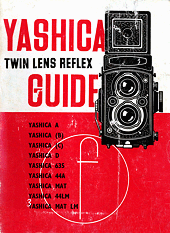 These web-pages have been scanned and converted from the original "Focal Press" publication "Yashica Twin Lens Reflex Guide", First Edition: January, 1964. Cameras covered are the Yashica A, Yashica B, Yashica C, Yashica D, Yashica 635, Yashica 44A, Yashica-MAT, Yashica 44LM and Yashica MAT LM cameras. Consequently it does not cover the later models such as the MAT 12, 24 and the later 124-Series Models. There may be reference to "current" and "discontinued" models. Obviously all Yashica TLR cameras described are now long discontinued, but for ease of editing if nothing else, all the original text has been retained.
These web-pages have been scanned and converted from the original "Focal Press" publication "Yashica Twin Lens Reflex Guide", First Edition: January, 1964. Cameras covered are the Yashica A, Yashica B, Yashica C, Yashica D, Yashica 635, Yashica 44A, Yashica-MAT, Yashica 44LM and Yashica MAT LM cameras. Consequently it does not cover the later models such as the MAT 12, 24 and the later 124-Series Models. There may be reference to "current" and "discontinued" models. Obviously all Yashica TLR cameras described are now long discontinued, but for ease of editing if nothing else, all the original text has been retained.
The original book was divided into two sections, effectively an overview and a "green pages" section covering specific models in more detail. I've not bothered with a green background to these pages, but hopefully I will have included links where appropriate to the relevant text.
Read the book online (below) or Download the manual in Acrobat PDF format (at the bottom of this page).
|
Yashica Twin Lens Reflex Guide
First Edition: January, 1964
How to Use
The Yashica A, Yashica B, Yashica C, Yashica D,
Yashica 635, Yashica 44A, Yashica-MAT, Yashica 44LM
and Yashica MAT LM cameras
By W. D. EMANUEL
The Focal Press
London and New York
|
Table of Contents
|
This is a Camera Guide. It deals with one make of camera, but it is not boosting it. The Camera Guide is a Focal Press publication. It is not sponsored or censured by manufacturers, or dependent on them in any way. The Camera Guide is as scrupulous in fully describing the camera and advising on its use as the very best type of manufacturers' book of instructions.
First Edition: January, 1964
How to Use
The Yashica A, Yashica B, Yashica C, Yashica D,
Yashica 635, Yashica 44A, Yashica-MAT, Yashica 44LM
and Yashica MAT LM cameras
By W. D. EMANUEL
Some items of equipment or certain materials mentioned in this book may not be freely available in every country. Import and marketing conditions vary widely, and are outside the control of the photographic dealer.
© Focal Press Ltd., 1964
Printed 1964 in Great Britain by The Sidney Press Ltd., Bedford
|
THE YASHICA REFLEX CAMERA
The Yashica rollfilm reflex cameras are twin-lens mirror reflex cameras made in two sizes, one taking 12 exposures of a size 2¼ x 2¼ in. (6 x 6 cm.) on standard 120 roll film, the other taking 12 exposures 1 5/8 X 1 5/8 in. (4 x 4 cm.) on 127 roll film.
Two lenses matched for focal length are mounted one above the other on a common panel. The upper lens projects an image of the subject via a mirror on to a ground glass screen in the top of the camera, while the lower one projects a similar image on to the film: the ground glass image therefore shows at all times the full-size picture as it will appear on the negative, upright but reversed left to right. To compensate for any parallax between the viewing and taking lens, the ground glass is suitably masked. The ground glass on top of the camera is protected in the closed position by the folded-down finder hood. When opened, this forms a light-excluding hood 2½ in. high; it carries a magnifier for critical focusing and has a built-in framefinder for eye-level direct vision.
The Yashica reflex cameras are focused by a large focusing knob on the side of the camera. This is geared to the front panel and smoothly and simultaneously controls both lenses. A depth of field indicator is incorporated.
A film speed indicator is built into the centre of the focusing knob except model D and 635, where it is in the film transport knob.
A tripod bush is located in the centre of the camera base. The back of the camera hinges open for insertion of the film. It carries a substantial spring-loaded pressure plate to locate the film precisely in its focal plane. The shutter is released by a body release knob on the front of the camera.
The body is diecast and leather covered. The dimensions of the 2¼ x 2¼ models are 5 5/8 X 4 1/8 x 3 ¾ in., weight
from 32 oz. to 40 oz. The 4 x 4 models measure 4½ 3¼ x 3¼ in. and weigh from 24 oz. to 29 oz.
|
The various Yashica rollfilm reflex models are distinguished from each other by the type of lens built-in, the number of shutter speeds, various automatic features and built-in exposure meter.
Some discontinued models of the Yashica reflex, such as models B, C and 44 which were on the market only for a short time, are so similar to the current ones that they have not been dealt with in the guide separately. There are also several transition variations of the Yashica reflex models listed below. These variations are of a minor nature and the consequent change in manipulation self-evident.
Yashica Reflex Models
The 2¼ x 2¼ in. models are:
- Yashica reflex A.
As general description above, fitted with Yashikor, earlier models with Yashimar f 3.5 80 mm. three-element, in four-speed Copal shutter, X flash synchronized, film transport by knob, non-automatic, accessory shoe fitted.
- Yashica reflex B.
Similar to A with aperture and shutter speed set by levers on either side of the shutter rim.
- Yashica reflex C.
Adds to model A semi-automatic film transport, speed range from 1 to 1/300 sec., field lens in focusing screen, full XM flash synchronization, Yashikor f3.5 80 mm. lens with bayonet mount for filters, built-in delayed action.
- Yashica reflex D.
Similar to model C with increased speed range 1 to 1/500 sec., aperture and speed setting in cut-out window above finder lens controlled by thumb wheels.
- Yashica reflex 635.
As model D with facilities for using 35 mm. miniature film by incorporating additionial transport knob, film counter and rewind control. Supplied with conversion kit.
- Yashica Mat reflex.
As general description above, fitted with Yashinon f3.5 80 mm. and finder lens f3.2, shutter 1 to 1/500 sec., built-in delayed action. fully XM synchronized. Aperture and speed setting in cut-out window above finder lens, controlled by thumb wheels with click stops. Film transport fully automatic by lever wind. Fresnel lens in reflex screen.
- Yashica Mal-LM.
As Yashica-Mat, but has built-in photo-electric exposure meter, uncoupled, scale built into focusing knob.
The 4 x 4 models are:
- Yashica 44.
As general description above with Yashikor f3.5 60 mm. lens in bayonet mount, crank handle for film transport. Copal shutter speeds 1 to 1/500 sec., built-in self-timer, fully XM synchronized, focusing screen with field lens.
- Yashica 44A.
As model 44 but lens with push-on mount, transport by wheel, non-automatic, shutter speeds1/25 to 1/300 sec., X synchronized, no delayed action release.
- Yashica 44LM.
As model 44 but with Yashinon f3.5 60 mm. lens, with built-in photo-electric exposure meter, uncoupled, scale built into film transport knob, semiautomatic film transport.
|
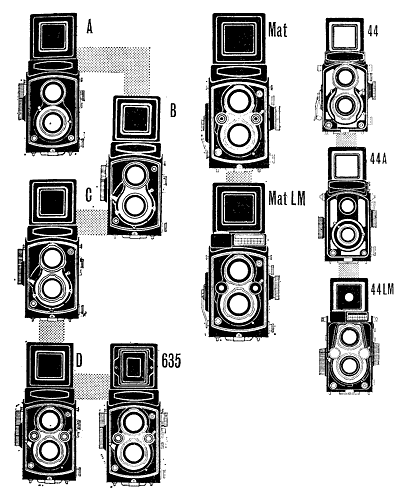 THE YASHICA MODELS
THE YASHICA MODELS
Model D developed from Model A via the now-discontinued B and C models. It has semi-automatic film transport and thumb-wheels for setting aperture and shutter speed. The Mat and Mat-LM have fully automatic film transport by lever wind . These are all 2¼ in. x 2¼ in. models, but the 635 version of Model D also takes 35 mm. film. The 4 cm x 4 cm. models are the 44 (now discontinued), the 44A (similar to Model A) and the 44LM, with built-in exposure meter.
|
HANDLING THE YASHICA REFLEX
In order to simplify the description and handling of the Yashica Reflex camera without being confused by different features of individual models, this guide has been divided into a general section which applies to all models, while the requirements and consequently different handling of each model are found on the "green pages".
For convenience, a symbolic reference system is also used in the general section. Wherever the sign # appears, further details will be found in the camera pages of the green section for each camera type. The appropriate pages are marked accordingly in the bottom left or right hand corner.
Holding
Hold the camera as steady as possible; the slightest shake, even if its effect is not visible in the negative, becomes apparent in the enlargement. Always stand with your legs apart for extra steadiness.
When working with the reflex finder at chest-level, place cameras which have the focusing knob on the left side in the palm of the right hand, with right index finger on the release on the front while thumb and index finger of the left hand rest on the focusing knob. On cameras with the focusing knob on the right side hold camera in the left hand with left index finger on the release, while thumb and index finger of the right hand move the focusing knob.
When using the eye-level finder hold up the camera so that the eye is level with the back sight in the focusing hood. Grip the body with both hands, placing the index finger of the right hand on the release. Press the camera body against nose and forehead to give it additional support.
To release the shutter, press the button with the right-hand index finger. Use finger pressure only, keeping the grip steady. The pressure must be slow and smooth. The slower the exposure time, the smoother must be the release, as the risk of camera shake and consequent blurring of the image is greater.
For slow speed exposures in the hand at chest-level, hold your breath and operate the release smoothly to avoid shake.
When using long exposures while holding the camera at eye-level rest the camera against some support, or at least lean against something stable. In this way 1/8 sec., or more, can be risked without incurring camera shake.
A tripod is advisable when taking exposures of 1/15 sec. or longer or with the delayed-action release.
|
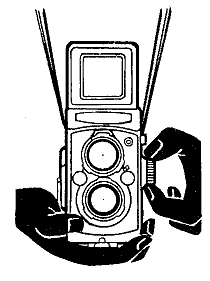
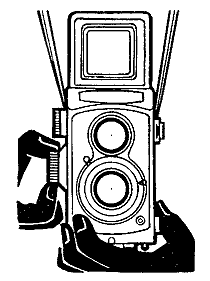
Left:
With these models which have the focusing knob on the left-hand side, support and steady the camera with your right hand thumb on the release button, and operate the focusing knob with the left hand.
Right:
Where the focusing knob is on the right-hand side, hold the camera in the left hand with the left index finger on the release and operate the focusing knob with the right hand.
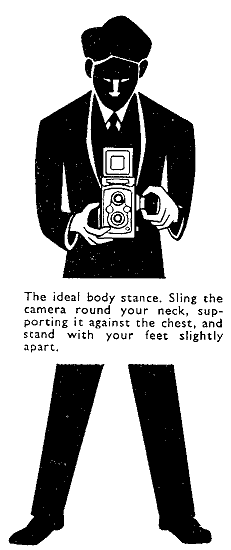
The ideal body stance. Sling the camera round your neck, supporting it against the chest, and stand with your feet slightly apart.
 Although the standard hold for the Yashica reflex is the steadiest, various alternatives are possible in special situations. You can hold the camera above your head to shoot over crowds, etc. (left); You can shoot round the corner (centre left) or for action subjects you can use the eye-level finder (centre right). For time exposures mount the camera on a tripod (right) and release the shutter with the aid of the cable release.
Although the standard hold for the Yashica reflex is the steadiest, various alternatives are possible in special situations. You can hold the camera above your head to shoot over crowds, etc. (left); You can shoot round the corner (centre left) or for action subjects you can use the eye-level finder (centre right). For time exposures mount the camera on a tripod (right) and release the shutter with the aid of the cable release.
|
Carrying
However elegant it may be to carry the camera on a long strap from the shoulder, this is quite unsuitable for quick action. A better method is to carry it on a short strap around the neck at chest-level ready for work.
The ever-ready case enables the Yashica reflex to be used without removing it from the case. The anchoring lugs on either side prevent the camera from failing out.
The Reflex Finder
The reflex finder is a viewing-cum-focusing device. It consists of a focusing screen on top of the camera and in most models additionally a fresnel screen. This gives an extremely bright image right to the edges, and high colour brilliance.
The image entering the camera through the finder lens is reflected on to it by a mirror. This reflex image remains visible even during and after the exposure.
Its purpose is first to show the exact picture area, and secondly to help in getting the picture sharp on the film.
Viewing
The picture on the screen appears upright but reversed left to right. Movements are also reversed left to right. To follow a moving object the camera must be turned against the apparent movement.
With the frame finder built into the focusing hood you can also follow movement -it shows an upright and right-way-round image.
When using the frame finder, do not attempt to turn the camera to the right or left away from the eye, nor try to move the eye from the centre of the back sight. This "spying round the corner" is deceptive, as only that section will appear on the negative which you see in the finder looking straight ahead with the eye close to and in the centre of the opening.
You will probably hold the camera reasonably level, but make sure that vertical lines of the picture run parallel with the lines engraved on the screen or the sides of the screen itself. You can tilt the camera intentionally, but make sure that the effect does not look like an accidental tilt.
Parallax Compensation
The reflex finder of the Yashica reflex is masked so that the field seen in it right down to 3½ ft. will appear on the negative.
The frame finder yields a view of its own as it views from a point away from the lens. The greater the distance between the two, the bigger the difference of this point of view, i.e. the parallax. Parallax hardly counts when viewing and taking a subject at distances down to 6 ft., as the difference of viewpoint is negligible as compared with the distance between camera and subject.
But if we photograph anything at close quarters-take a portrait for example-the parallax may show. The image as seen through the frame finder may include all of, say, a hat worn by the subject of your portrait, while quite a portion of it may be cut off in the picture taken. So do not use the frame finder at close quarters. If you must use it, make allowances by including in the frame finder view a strip at the top of the frame that you can do without in the picture. And the closer You are to tile Subject, the wider that strip must be.
|
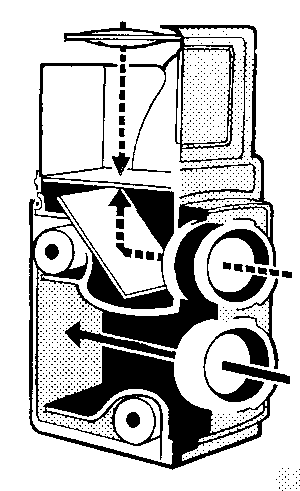 VIEWFINDERS
VIEWFINDERS
Left: The standard method of viewing with the Yashica is to look straight down on the ground-glass screen in the top of the camera. A large hinged magnifier in the hood swings out to enlarge the whole screen area. You can thus judge the image sharpness really accurately.
|
Below: To raise the magnifier, press the front of the focusing hood cover inwards (left), holding the focussing hood so that it does not close. To lower the magnifier, press downwards on the rim. Be careful to lower the magnifier before closing the focusing hood.
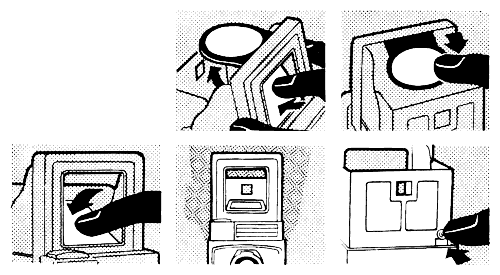 Above: For moving subjects, the direct-view sportsfinder is often preferable. To use the finder, push he front of the focusing hood cover inward and downward until it clicks into place (left). Sight Your subject through the smaller aperture at the back of the focusing hood (centre). To close the frame, push the button at the bottom right of the back of the focusing sing hood (right).
Above: For moving subjects, the direct-view sportsfinder is often preferable. To use the finder, push he front of the focusing hood cover inward and downward until it clicks into place (left). Sight Your subject through the smaller aperture at the back of the focusing hood (centre). To close the frame, push the button at the bottom right of the back of the focusing sing hood (right).
|
Focusing
The second purpose of the reflex finder -obtaining the best possible definition- is at the same time one of the most important aids to obtaining good results.
The less experienced user of the reflex screen is apt to accept all too hastily, a seemingly sharp impression of the image for satisfactory definition. There are, however, different degrees of sharpness and you can make use of these very differences to find the best possible setting.
Turn the focusing knob to and fro while observing how the main object to be focused becomes more and more sharp up to a point beyond which it again loses definition.
At this "beyond" stage reverse the movement of the focusing knob. Slowly narrow down the degree of to and fro movement of the focusing knob until you unmistakably arrive at the point of the very best definition.
You encircle, as it were, the point which you want absolutely sharp by going over and over again its neighbourhood, all of which will appear reasonably sharp. Before or beyond the point of maximum definition the image still appears sufficiently sharp, but do not be deceived by this fact: the image is not good enough for enlarging.
When watching the screen at waist level, swing the built-in magnifying glass into position by pressing the front flap of the reflex hood inwards. This helps to check critical sharpness. The camera is best raised near to the eye when using the magnifier.
When you have finished with the magnifier, lower it again. If you keep it in front of the screen you may get
excellent definition, but are apt to lose sight of the picture as a whole.
The frame finder cannot be used for focusing. Generally the best way is to use first the reflex finder for focusing and then change over to the frame finder for viewing.
This procedure is unsuitable for photographing moving subjects. The frame finder is, however, more effective with zone focusing methods (p.49). These ensure that all subjects within a certain depth of field will be recorded sharply. Zone focusing is, in fact, preferable to any other method when dealing with rapidly moving subjects in front of a reflex camera. It is almost impossible to catch and shoot fast motion when your attention is fixed on the mirrored image that shows directions and movement the wrong way round. With a frame finder it is quite easy to follow everything and keep the other eye on the subject before it comes into the field of the finder.
Alternatively, for action shots, you can pre-focus the camera at a distance at which the subject will be at a given moment, or focus on a spot which the subject has to pass.
With subjects liable to react self-consciously (e.g., children), focus on some object which is the same distance from the camera as your real subject, but in a different direction. When the range is found, swing the camera round and shoot.
Shooting
Practise the following operations first with an empty camera until you can do them practically automatically.
- Transport the film.
- Select shutter speed.
- Select aperture.
a. Cock shutter-on models with film transport wheel only.
- Focus and determine picture area to obtain a sharp picture and the view you want.
- Release the shutter gently.
|
Loading and Unloading
The Yashica reflex uses standard size 120 roll film. It gives 12 exposures 2¼ x 2¼ in. (6 x 6 cm.). The Yashica reflex "44" uses 127 size roll film for 12 exposures 1 5/6 x 1 5/8 in. (4 x 4 cm.). These are film spools which are loaded into the camera in daylight. Avoid loading or unloading the camera in brilliant sunlight. Choose a shady spot or do it in the shadow of your own body if nothing better is available.
Loading
1. Open camera back
by holding the carriers upside down, and turning the ring on the base in the direction of the arrow marked 0, that is anti-clockwise, fold away the back cover.
2. Insert the film.
The empty spool in the bottom chamber has to be transferred into the top chamber. Pull out the spring knob on the camera side wall, remove the empty spool and insert it into the top chamber. For this purpose, pull out the spring-loaded knob of top chamber. Place the empty spool with the grooved end towards the film transport into the top chamber so that the groove engages in the film transport cross bar. Now allow the spring catch to spring back into its original position and so engage the empty spool in the chamber. For model 44LM see #.
Insert the roll of film in the bottom chamber after breaking the seal so that the pointed end of the backing paper points upwards towards the empty spool. Pull the paper end over the film aperture to the empty take-up spool. Insert the wedge-shaped end of the paper into the wide slot of the take-up spool.
On all Yashica reflex models without a red film window in the camera back, transport the film until the lateral double arrow (on some makes of film, triangular marks) printed on the film backing paper point to the red triangular marks on either side of the centre of the film aperture of the camera.
3. Close the camera
by pushing the back panel against the camera body and turn the ring on the base in the direction of the arrow marked C, that is, in a clockwise direction, to lock the back to the body.
4. Get the film ready for the first exposure #.
5. Set film speed and type #.
|
LOADING

Above, left to right: With the Yashica A and 44A open the camera back, insert the film and attach the end to the take-up spool. Close the camera and wind the film on until No.1 appears in the he red window (far right).
|

 Above left to right. With the Yashica D, 635 and Yashica-Mats, open camera back, insert film and attach to take-up spool. Wind film until crossbar on paper points to arrowheads on camera body and close camera back. Turn winder of semi-automatic models (right) or turn crank of automatic models (far right) until No.1 appears in film counter window.
Above left to right. With the Yashica D, 635 and Yashica-Mats, open camera back, insert film and attach to take-up spool. Wind film until crossbar on paper points to arrowheads on camera body and close camera back. Turn winder of semi-automatic models (right) or turn crank of automatic models (far right) until No.1 appears in film counter window.
|

 Above, left to right: With Yashica 44LM open camera back, insert film and attach to take-up spool and close camera back. Turn the film winding knob (right) until No.1 appears in the red window. Set the automatic counter to No.1 (far right) by pushing the reset button backward while deressing the film release button.
Above, left to right: With Yashica 44LM open camera back, insert film and attach to take-up spool and close camera back. Turn the film winding knob (right) until No.1 appears in the red window. Set the automatic counter to No.1 (far right) by pushing the reset button backward while deressing the film release button.
|
THE YASHICA REFLEX: MODEL BY MODEL
These "green pages" (Ed. : in the original booklet actual green paper was used) deal with the individual Yashica Reflexes in detail.
Self-contained sections for each model cover Points of loading, unloading, shooting and specific controls.
For a fuller explanation of aspects common to all Yashica Reflexes, compare these sections with the same headings in the main text.
Yashica A and 44A
- Loading
- Unloading
- Shooting
- Special Controls
Yashica D and 635
- Loading
- Unloading
- Shooting
- Special Controls
- Using 35 mm. film in Yashica 635
- Unloading 35 mm. film
- Shooting with 35 mm. film
Yashica Mat and Mat LM
- Loading
- Unloading
- Shooting
- Special Controls
- Photo-electric exposure meter of Mat LM
- Using the meter
Yashica 44 LM
- Loading
- Unloading
- Shooting
- Photo-electric exposure meter
- Using the meter
- Special controls
Note:
The shutters of current Yashica models D, 635 MAT, MAT LM and 44LM use the new standard speeds of 1,½,¼, 1/8, 1/15, 1/30, 1/60, etc., as shown in the following pages. Earlier models used the speeds 1,½, 1/5, 1/10,1/25, 1/50, etc.
|
YASHICA A AND YASHICA 44A
The Yashica A and 44A are equipped with f 3.5 Yashikor, a three-element triplet of 80 mm. focal length in case of the 2¼ x 2¼ model and 60 mm. in the 4 x 4 model as both taking and viewing lens. The shutter is the "Copal" four-speed (1/25, 1/50 1/100 and 1/300 sec. and B for time exposures) with X synchronization. The aperture adjustment is from f3.5 to f22. Focusing is by wheel on the side of the camera with distances engraved in feet and metres. A depth of field indicator is engraved on the camera body above the distance wheel. A reminder disc for the speed of film loaded into the camera is built into the film transport knob in the 2¼ x 2¼ and in the focusing knob in the 4 x 4 model. An accessory shoe is fitted to the left side of the camera, primarily intended to accept a flash gun.
The folding reflex finder hood, opened and closed by one hand action, incorporates a frame finder and a focusing magnifier. The focusing screen of the 44A model incorporates a fresnel screen for enhanced brightness and even illumination.
The camera back is hinged on and has a pressure plate and red film window with cover. The film transport is the conventional way by transporting the next number into the film window.
Model A accepts push-on filters, close-up lenses and lens hood of 32 mm. diameter.
Model 44A accepts push-on filters, close-up lenses and lens hood of 28.5 mm. diameter.
ACCESSORIES for Yashica A and 44A include filters for black-and-white and colour photography, 1 and 2 diopter close-up lens pairs, lens hood and hand grip.
Loading
- Open camera back.
- Insert the film.
- Close camera back.
- Get film ready for the first exposure by turning the film transport knob until the film counter window in the back of the carnera shows No.1.
- Set film speed on the film reminder disc (in transport knob of model A and in focusing knob of model 44A) by turning the ASA or DIN speed of the film used opposite the indicator dot on the rim. This has no function as far as working the camera is concerned. It is simply a reminder.
Unloading
- Wind off the film after all 12 exposures have been taken by turning the film transport knob until the film backing paper has passed the film window, then give another 2 turns.
- Open camera back.
- Remove the exposed film, close back or reload with new film.
Shooting
- Advance the film to the next number in the film window with the film transport knob.
- Select the shutter speed by turning the outer serrated rim of the shutter until the speed required points to its arrow head pointer. The figures engraved 25, 50, 100, 300 are fractions of seconds and stand therefore for1/25, 1/50, 1/100, 1/300 sec. See also chapter on Exposure.
- Select the aperture by turning tine lever pointing to the aperture scale to the aperture value, 3.5, 4, 5.6, 8, 11, 16 or 22 which is there engraved. See also chapter on "'Exposure".
a. Cock shutter by pushing down cocking lever protruding outside the shutter speed scale as far as it will go and let it snap back.
- Focus and determine picture area. See p.10, "The Reflex Finder".
- Release the shutter by gently pressing the release button on the camera front.
Special Controls
TIME EXPOSURES are made by setting the shutter to B - the shutter will remain open as long as the release is depressed. Use a cable release. See chapter on "Exposure".
FLASH SYNCHRONIZATION. The shutter is X flash, synchronized. The flash contact is on the base of the camera front. See chapter on "Flash".
|
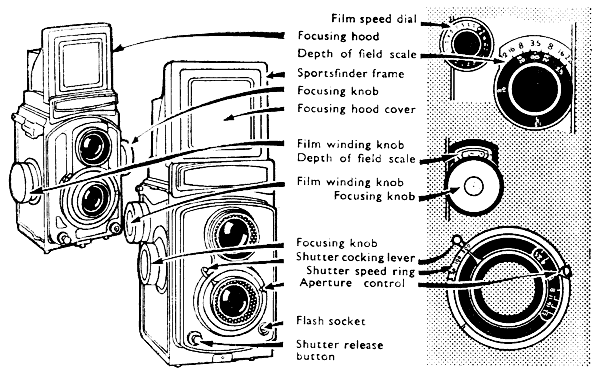
Model A (right) has a focusing knob for right-handed operation with the film-winding knob just above it. The 44A (left) has left-handed focusing with film wind on the right. Otherwise the cameras are similar, with magnifying glass to facilitate focusing sportsfinder frame and flash synchronization. The shutter speed ring and aperture control are around the taking lens. The shutter release button is at the bottom front of the camera for right index finger operation.

Shooting with the Yashica A and 44A.
From left to right: Advance the film and select the shutter speed. Select aperture and cock shutter. Focus the picture on the screen and press the shutter release.
|
YASHICA D AND 635
The Yashica D and 635 are equipped with f 3.5 Yashikor, a three-element triplet of 80 mm. focal length for both taking and viewing lens. The shutter is the Copal MXV, giving speeds 1,½,¼, 1/8, 1/15, 1/30, 1/60, 1/125,1/250 and 1/500 sec. and B for time exposures, with XM flash synchronization and built-in delayed-action release. The shutter speed and the aperture are actuated by thumb wheels on either side of the shutter and are read off in a cut-out window above the finder lens.
Focusing is by wheel on the side of the camera with distances engraved in feet and metres. A depth of field indicator is engraved on the camera body above the focusing wheel.
The film transport is semi-automatic by transport wheel which locks when the next frame is in position. An automatic exposure counter in the side wall of the camera shows the number of frames transported. A reminder disc showing the speed of the film loaded into the camera is built into the film transport knob. An accessory shoe is fitted to the left-hand side of the body, primarily intended to accept a flash gun.
The folding reflex finder hood, opened and closed by one hand operation, incorporates frame finder and focusing magnifier. The focusing screen incorporates a fresnel screen giving enhanced brightness and even illumination.
The camera back is hinged on and incorporates a film pressure plate.
THE MODEL 635 has an additional transport knob, film counter and rewind control for using 35 mm. films in conjunction with a 35 mm. kit supplied with the camera. This kit consists of 35 mm. auxiliary spool assembly, convertor mask unit, film pressure plate, supporter shaft, adapter ring and frame finder mask, all contained in a small leather case. The ground glass screen has red lines engraved on it showing the field of the 35 mm. size.
BOTH MODELS have a bayonet mount around viewing and taking lenses to accept bayonet-mounted filters, close-up lenses and lens hood.
ACCESSORIES for Yashica D and 635 include filters for colour and black-and-white photography, close-up lens sets with built-in wedge for parallax compensation, lens hood and hand grips.
Loading
- Open camera back.
- Insert the film and turn film transport knob until lateral double arrow or bar printed on the backing paper points to the red markers on either side of the film aperture of the camera body.
- Close camera back, the letter s (= start) will automatically appear in the film counter window.
- Get film ready for first exposure by turning film transport knob until the number 1 appears in the film counter window. The transport then becomes locked in this position.
- Set film speed on the reminder disc by turning the ASA or DIN speed of the film used opposite the indicator dot on the rim. This has no function as far as working the camera is concerned. It is simply a reminder.
Unloading
- Wind off film, after all 12 exposures have been taken, by turning the film transport knob another 6 turns to wind off the remainder of film and backing paper.
- Open camera back.
- Remove the exposed film, close back or reload with new film.
Shooting
- Advance the film to the next number by pressing the film release button in the centre of the film transport knob and turning the knob until it locks. The next number then shows in the film counter window.
- Select shutter speed by turning the thumb wheel (right) until the speed required appears in the cut-out window on top of the finder lens. The figures engraved 1, 2, 4, 8, 15, 30, 60, 125, 250, 500 are fractions of seconds and stand for 1/1,½,¼, 1/8, 1/15, 1/30, 1/60, 1/125,1/250, 1/500 sec. See also the chapter on "Exposure".
- Select aperture by turning the thumb wheel (left) until the required aperture appears in the cut-out window on top of the finder lens.
See also the chapter on "Exposure".
a. Cock shutter by pushing down the cocking lever below the speed setting thumb wheel as far as it will go and let it snap back.
- Focus and determine picture area. See also paragraph "The Reflex Finder".
- Release the shutter gently by pressing the release button on the camera front.
Special Controls
TIME EXPOSURES are made by setting the shutter to B. The shutter remains open as long as the release is depressed. Use a cable
release. See the chapter on "Exposure".
FLASH SYNCHRONIZATION. The camera is XM synchronized and is set to the X or M position by pushing the lever (with yellow head) behind the aperture thumb wheel to the engraved X or M. See the chapter on "Flash".
SELF-TIMER (delayed action release). This permits the photographer to appear in the picture. Place the camera on a tripod or other rigid support. Set flash synchronizing lever to X and push down the delayed-action lever (with red head) on the base of the shutter as far as it will go. On pressing the shutter release, the shutter opens after a delay of approximately 10 sec. The delayed action can be used with all speeds from 1-1/500 sec. If set to B, it will release but gives a speed of approximately 1/60 sec.
It can also be used with flash shots, but only with X synchronization.
|
YASHICA D AND 635
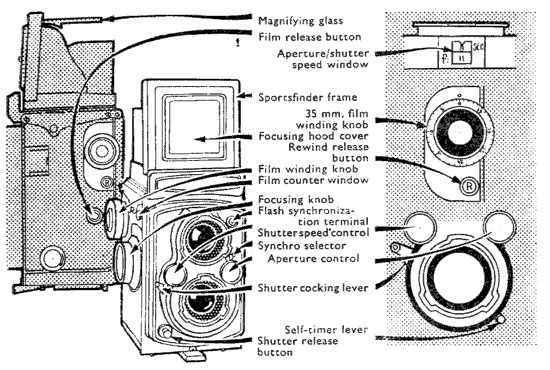
The magnifying glass permits close inspection of the ground-glass image for critical focusing. Aperture and shutter seed setting are visible in a window on top of the lens mount. The red line in the window should run through the centre of the figures. The sportsfinder makes it easier to view moving subjects. The synchro selector provides X and M Settings. A self-timer is fitted and is controlled by a lever at bottom of the lens mount.

Shooting with the Yashica D and 635. From left to right: Advance the film by pushing the film release button and turning the film winding knob to the automatic stop. Set shutter speed and aperture. Cock the shutter. Focus the picture on the screen and press the shutter release.
|
Using 35 mm. Film in Yashica 635
To prepare the camera and load with 35 mm film:
- Pull out rewind release button engraved "R".
- Insert 35 mm. converter mask by pointing the sprockets of the mask towards top chamber. Spring the lower part into the film aperture by exerting slight pressure on the spring base of the mask.
- Let rewind release button "R" snap back into its original position so that it engages the sprocket wheel.
- Screw the adapter ring (squat, outside milled) to the film spool support shaft on the right-hand side of the lower film chamber.
- Engage the auxiliary support shaft (stepped rod) with the spool of the film cassette.
- Place the thus prepared film cassette into the lower film chamber by pulling out the spring-loaded film spool holder on left.
- Place the 35 mm. take-up spool into the top film chamber (after having removed the rollfilm spool) so that the cut-out of the black end engages the key of the transport wheel. Pull out the 35 mm. film wind knob (left) to enable the take-up spool to fit into the chamber. Let the 35 mm. film wind knob spring back and give it a few turns until the take-up spool starts to turn too. If the 35 mm. film wind knob is locked, press the film release button (below the "R" button) to release the lock.
- Pull out the film end and draw it over the film aperture, threading the end into the slot of the take-up spool in the upper chamber. Now turn the 35 mm. film winding knob to make sure that the film perforations engage in the sprockets of the mask.
- Place the film pressure plate with its two pins into the corresponding holes in the mask.
- Close camera back. Press film release button once and turn 35 mm. film winder as far as it will go. Do this three times.
- Set exposure counter on the base of the 35 mm. film winder by its serrated rim until number 1 is opposite its white indicator dot.
The film is now in position for the first exposure. Generally you will find that 1 exposure less is obtained than indicated on the film, e.g. on a 36 exposure film 35 on a 20 exposure film 19 exposures. It is advisable to stop at 35 or 19 exposures respectively to obtain easy rewind.
Unloading 35 mm. Film
After all exposures have been made the 35 mm. film has to be rewound into its cassette. To do this:
- Pull out the rewind release button "R" and give it a slight turn to keep it in this position.
- Rewind film by turning the protruding film spool locking knob on the base of the side wall of the camera (which also carries the 35 mm. film wind knob) in a clockwise direction until all film is rewound into the cassette.
- Open camera back and remove cassette by pulling out film spool locking knob, close camera. Make certain to remove and retain the auxiliary supporter shaft (stepped rod) from the cassette. You need it for the next and all future cassettes you load into the camera,
Shooting with 35 mm. Film
- Advance the film to the next frame by pressing the 35 mm. film release button and turn the 35 mm. winding knob as far as it will go.
- Set shutter speed and aperture and cock shutter as described for shooting with roll film. (steps 2 and 3)
- Focus and determine picture area. The picture area for 35 mm. film is indicated on the reflex screen by the red lines. The image at infinity to 10 ft. is represented by the rectangle without the lower strip, at 3.5 ft. by that without the upper strip but including the lower one, at distances between 10 and 3.5 ft. appropriate between settings.
Where using the eye-level frame finder, attach the frame finder mask provided with the conversion kit into the 2¼ x 2¼ frame to reduce the field of view to correspond with the 35 mm. size.
- Release the shutter.
|
USING 35 mm. FILMS
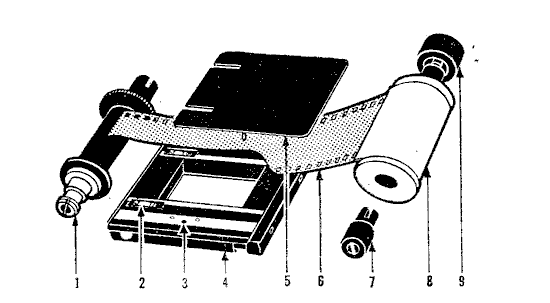
Above: The 35 mm. conversion unit for Model 635. 1. auxiliary spool assembly; 2. sprocket; 3. pressure plate aligning hole; 4. converter mask assembly; 5. film pressure plate; 6. 35 mm. film; 7. auxiliary supporter shaft; 8. film cassette; 9. metal adapter ring.
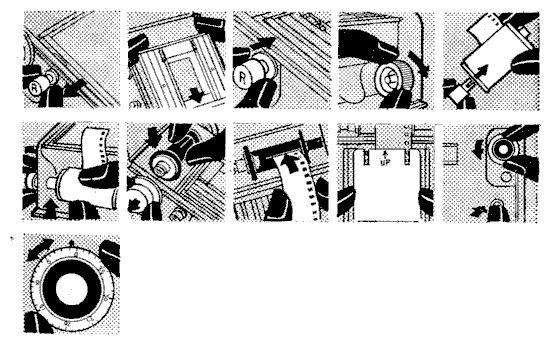
Top row, left to right: To adapt the camera, pull out the rewind release button, insert the converter mask and let the button snap back. Screw the adapter spool spool supporter shaft and attach the auxiliary shaft to the cassette spool.
Above, left to right: Insert the cassette in the camera and place the take-up spool in the top chamber. Fix the film end to the take-up spool. Insert the pressure plate and close camera back. Release the shutter and wind the film on three times. Finally (bottom-left), set the exposure counter to No. 1.
|
YASHICA MAT AND YASHICA MAT LM
Yashica Mat and Yashica Mat LM are equipped with f 3.5 Yashinon, a four-element triplet of 80 mm. focal length as taking lens and an f 3.2 Yashinon as viewing lens. The shutter is the Copal MXV giving speeds 1,½,¼, 1/8, 1/15, 1/30, 1/60, 1/125,1/250 and 1/500 sec. and B for time exposure with XM flash synchronization and built-in delayed action release. The shutter speed and the aperture are actuated by thumb wheels on either side of the shutter and are read off in a cut-out window above the finder lens.
Focusing is by wheel on the side of the camera with distances engraved in feet and metres. A depth of field indicator is engraved on the camera body above the focusing wheel.
The film transport is fully automatic by lever wind. One movement advances film, sets shutter and operates exposure counter and is interlocked with shutter release to prevent double exposures.
The folding reflex finder hood, opened and closed by one hand operation, incorporates a frame finder and focusing magnifier. The focusing screen incorporates a fresnel screen giving enhanced brightness and even illumination.
The camera back is hinged on and incorporates a film pressure plate.
THE YASHICA MAT has a reminder disc in the centre of the focusing wheel showing the speed of the film loaded into the camera.
THE YASHICA MAT LM has a built-in photo-electric exposure meter. The cell is incorporated in the top of the front plate of the camera and the light reading window is adjacent to it. The exposure setting scale is in the centre of the focusing knob.
BOTH MODELS have a bayonet mount around viewing and taking tenses to accept filters, close-up lenses and lens hood.
ACCESSORIES for Yashica Mat and Mat LM include filters for colour and black-and-white photography, close-up lens sets with built-in wedge for parallax compensation, lens hood and hand grip.
NOTE: To operate the transport crank without film in the camera, remove the take-up spool from the upper chamber. The automatic mechanism of the Yashica Mat and ML may jam if the crank is operated with only the bare metal spool in the take-up position.
Loading
- Open camera back.
- Insert the film and turn up the transport crank and wind it slowly in a clockwise direction until the lateral double arrow or bar printed on the backing paper of the film points to the red markers on either side of the film aperture on the camera body.
- Close camera back. The letter S (= start) automatically appears in the film counter window.
- Get film ready for first exposure by turning the crank handle forward until it comes to a stop. The number 1 appears in the film counter window. Turn the crank handle backwards (anticlockwise) until it stops and fold it over into its rest position.
The crank handle should be operated gently. The forward cranking movement must be completed before it is brought back. The shutter should not be kept cocked for long periods. It would tend in time to weaken the shutter spring and you also could inadvertently press the release and waste a film frame. Therefore, crank for first and subsequent exposures just before you are ready to take the photograph.
- Set film speed on Yashica Mat on the reminder disc by turning the ASA or DIN speed of the film used opposite the indicator dot on the rim. This has no function as far as working the camera is concerned; it is solely intended as a reminder.
On the Yashica Mat LM set the ASA speed on the exposure setting scale. (See below under "Photo-electric Exposure Meter").
Unloading
- Wind off film, after all 12 exposures have been taken, by turning the film crank handle another 6 turns to wind off the remainder of film and backing paper.
- Open camera back.
- Remove the exposed film, close back or reload with new film.
Shooting
- Advance the film to the next number by turning up the crank handle and swinging it smoothly forward-downwards to its stop and then backward to its stop and fold it over into its rest position. The next number will then show in the film counter window.
- Select shutter speed by turning the thumb wheel (right) until the speed required appears in the cut out window on the top of the finder lens, the figures engraved 1, 2, 4, 8, 15, 30, 60, 125, 250, 500 are fractions of seconds and stand for 1/1,½,¼, 1/15, 1/30, 1/60, 1/125,1/250, 1/500 sec. See also the chapter on "Exposure".
- Select aperture by turning the thumb wheel (left) until the required aperture appears in the cut-out window on top of the finder lens. See also the chapter on "Exposure".
- Focus and determine picture area. See p. 10, "The Reflex Finder".
- Release the shutter gently by pressing the release button on the camera front.
Special Controls
TIME EXPOSURES are made by setting the shutter to B - the shutter will remain open as long as the release is depressed. Use a cable release. See the chapter on "Exposure".
FLASH SYNCHRONIZATION. The shutter is XM synchronized and is set to the X or M position by pushing the lever (with yellow head) behind the aperture thumb wheel to the engraved X or M. See the chapter on "Flash".
SELF-TIMER (delayed action release). This permits the photographer to appear in the picture. Place the camera on a tripod or other rigid support. Set flash synchronizing lever to X and push down the delayed action lever (with red head) on the base of the shutter as far as it will go. On pressing the shutter release, the shutter opens after a delay of approximately 10 sec. The delayed action can be used with all speeds from 1-1/500 sec. If set to B it will release but gives a speed of approximately 1/60 sec.
It can also be used with flash shots, but only with X Synchronization.
|
YASHICA MAT AND YASHICA MAT LM
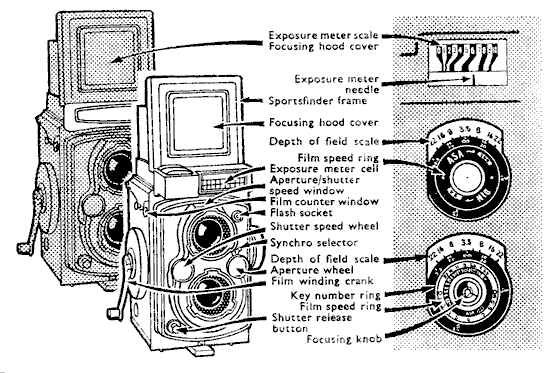
These models are similar, but the Mat LM has a built-in exposure meter. The exposure meter cell measures the light an and indicates a key number in the exposure meter window. This is transferred to the key number ring to give suitable settings of the shutter speed wheel and aperture wheel. The settings can be seen in the aperture/shutter speed window. The focusing hood of both models incorporates a magnifier and sportsfinder frame. The flash socket is at the top of the camera front and the shutter release button at the bottom. Film transport is by a film winding crank for right-handed operation, with the focusing knob on the left.

Shooting with Yashica Mat and Mat LM. Left to right: Advance the film by winding the crank forward until it stops and then back until it stops. This also cocks the shutter. Set aperture and shutter speed. Focus the picture on the screen and press shutter release. (Using the exposure meter, see p.14.)
|
The Photoelectric Exposure Meter
The Yashica MAT LM has an exposure meter built into the camera top plate with a light reading window (observed from above through a built-in magnifier) on its right. The reading is converted into aperture/shutter speeds for the speed of the film in the camera by an exposure reading scale built into the focusing ring. See the chapter on "Exposure" for selection of appropriate aperture/speed pairing. The reading scale is calibrated in ASA film speeds. If the film speed is known in DIN, a conversion scale from DIN to ASA on the base plate of the transport crank (on later models only) will permit reading off the equivalent in ASA.
Using the Meter
- Set ASA speed of the film used on the exposure setting reading scale in the focusing ring by turning the inner black disc until the ASA value appears in the cut out.
- Point camera at subject.
- Read off the key number to which the needle in the light reading window points.
- Set key number (white on red base) opposite its red dot on outer rim of exposure reading scale.
- Read off correct aperture opposite the shutter speed required on the opposite side of the ring.
- Transfer aperture/shutter speed to camera.
|
USING THE METER
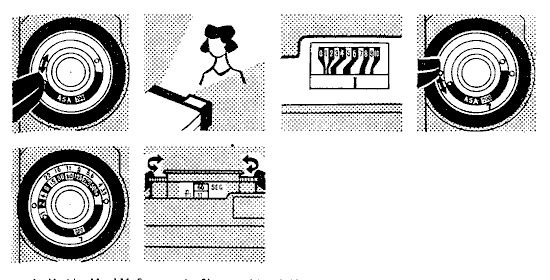
On the Yashica Mat LM, first set the film speed (top left). Point the camera at the subject and read Off the key number indicated in the exposure meter window (top centre). Turn the key number ring until this number is opposite the black dot on the outer rim of the focusing knob (top right). Select an aperture/shutter speed combination from those appearing on the other side of the knob (above left) and set this combination by means of the aperture and shutter speed wheels (above right),
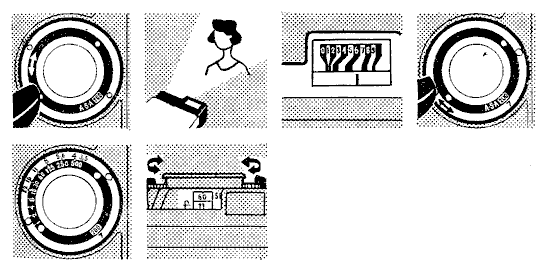
On the Yashica 44LM first set the film speed (top left). Point the camera at the subject and read off the key number indicated in the exposure meter window (top centre). Turn the key number ring until this number is opposite the white dot on the outer rim of the focussing knob (top rght). Select an aperture/shutter speed combination from those appearing on the other side of the knob (above left) and set this combination by means of the aperture and shutter speed wheels (above right).
|
YASHICA 44LM
The Yashica 44LM is equipped with f 3.5 Yashinon, a four-element triplet of 60 mm. focal length for both taking and viewing lens. The shutter is the Copal SV giving speeds 1,½,¼, 1/8, 1/15, 1/30, 1/60, 1/125,1/250 and 1/500 sec. and B for time exposures with XM flash synchronization and built-in delayed-action release. The shutter speed and the aperture are actuated by thumb wheels on either side of the shutter and are read off in a cut-out window above the finder lens.
Focusing is by wheel on the side of the camera with distances engraved in feet and metres. A depth of field indicator is engraved on the camera body above the focusing wheel.
The film transport is semi-automatic by transport wheel which locks when the next frame is in position. An automatic exposure counter in the side wall of the camera shows the number of frames transported. An accessory shoe is fitted on the left-hand side of the body, primarily intended to accept a flash gun.
The folding reflex finder hood, opened and closed by one hand operation, incorporates a frame finder and focusing magnifier. The focusing screen incorporates a fresnel screen giving enhanced brightness and even illumination.
The camera back is hinged on and incorporates a film pressure plate.
The Yashica 44LM has a built-in photo-electric exposure meter. The cell is incorporated in top of the front plate of the camera and the light reading window is adjacent to it. The exposure setting scale is in the centre of the focusing knob. A film speed converter from DIN to ASA is built into the focusing knob.
The Yashica 44LM has a bayonet mount around viewing and taking lenses to accept bayonet-mounted filters, close-up lenses and lens hood.
ACCESSORIES for Yashica 44LM include filters for colour and black-and-white photography, close-up lens sets with built-in wedge for parallax compensation, lens hood and hand grip.
Loading
- Open camera back.
- Insert the film. To remove empty take-up spool from the top chamber, press the serrated, chromed stud on the left of the spool downwards. Then press down the right side of the spool and it will spring up. Now place the take-up spool into the lower chamber, by pushing its shaft to the left towards the spring-loaded spool holder. Place the film in the top chamber by engaging the right end of the spool shaft in the hollow on the right-hand side, and pushing it gently down on the left when it will automatically engage and lock in position. Pull paper end of film spool across film aperture and over the roller bar into the wide slot of the take-up spool.
- Close camera back.
- Get film ready for first exposure by turning the film winding knob until the figure 1 appears in the red film window on the back of the camera. Push the exposure counter reset button (above the film transport wheel) backwards, while at the same time pressing in the film release button (that is, the centre of the film transport knob). The film is now ready for the first exposure.
- Set film speed on the exposure setting scale in the film transport knob by turning the inner black disc until the ASA speed of the film inserted into the camera appears in the cut-out beside the engraved "ASA".
Unloading
- Wind off film, after all 12 exposures have been taken, by operating the film transport knob (the automatic film counting window will show a red circle O) until the backing paper disappears from the red film window in the back of the camera and give another two turns.
- Open camera back.
- Remove the exposed film by pushing it to the left, when it will spring out. Close back or reload with film.
Shooting
- Advance the film. Press film release button in the centre of the film transport knob and turn the knob as far as it will go. The next number will then appear in the automatic film counter window.
- Select shutter speed by turning the thumb wheel (right) until the speed required appears in the cut-out window on the top of the finder lens. The figures engraved 1, 2, 4, 8, 15, 30, 60, 125, 250, 500 are fractions of seconds and stand for 1/1,½,¼, 1/8, 1/15, 1/30, 1/60, 1/125,1/250, 1/500 sec. See also the chapter on "Exposure".
- Select aperture by turning the thumb wheel (left) until the required aperture appears in the cut-out window on top of the finder lens. The correct aperture for any pre-selected shutter speed is determined with the built-in exposure meter (see below).
- Focus and determine picture area. See the chapter on "The Reflex Finder".
- Release the shutter by gently pressing the release button on the camera front.
The Photo-electric Exposure Meter
The Yashica 44LM has an exposure meter built into the camera top plate with a light reading window (observed from above through a built-in magnifier) on its right. The reading is converted into aperture/ shutter speeds for the speed of the film in the camera by an exposure reading scale built into the film transport knob. See the chapter on 'Exposure" for selection of appropriate aperture/speed pairing. The reading scale is calibrated in ASA film speeds. If the film speed is known in DIN, a conversion scale from DIN to ASA in the centre of the focusing knob Permits reading off the equivalent in ASA.
Using the Meter
- Set ASA speed of the film used on the exposure setting reading scale in the film transport knob by turning the inner black disc until the ASA value appears in the cut-out.
- Point camera to subject.
- Read off the key number to which the needle in the light reading window points.
- Set key number (white on red base) opposite its white indicator mark on outer rim of exposure reading scale.
- Read off correct aperture opposite the shutter speed required on the opposite side of the ring.
- Transfer aperture/shutter speed to camera.
Special Controls
TIME EXPOSURES are made by Setting the shutter to B. The shutter then remains open as long as the release is depressed. Use a cable release. See the chapter on "Exposure".
FLASH SYNCHRONIZATION. The shutter is XM synchronized and is set to the X or M position by pushing the lever (with yellow head) behind the aperture thumb wheel to the engraved X or M. See the chapter on "Flash".
SELF-TIMER (delayed action release). This permits the photographer to appear in the picture. Place the camera on a tripod or other rigid support. Set flash synchronizing lever to X and push down the delayed-action lever (with red head) on the base of the shutter as far as it will go. On pressing the shutter release, the shutter opens after a delay of approximately 10 sec. The delayed action can be used with all speeds from 1-1/500 sec. If set to B it will release but gives a speed of approximately 1/60 sec.
It can also be used with flash shots, but only with X synchronization.
|
YASHICA 44LM
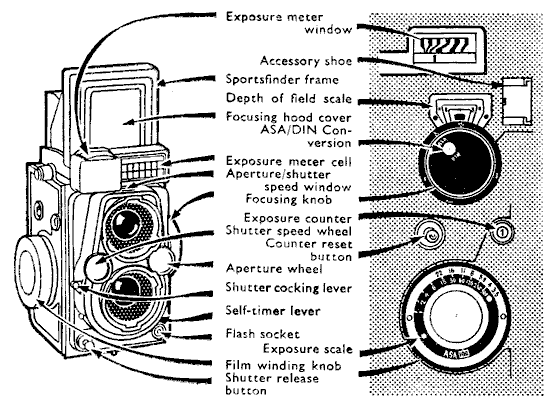
The exposure meter cell measures the light and presents a reading at he exposure meter window. The focusing knob carries an ASA/DIN conversion scale to facilitate setting the film speed on the exposure scale on the film winding knob. There is a depth of field scale over the focussing knob. Over the film winding knob are the exposure counter and counter reset button. The flash socket and shutter release are at the bottom of the camera front. The focussing hood carries a magnifier and a sportsfinder frame. Aperture and shutter speed are selected by means of wheels located between the two lenses, one on either side of the camera front.

Shooting with the Yashica 44LM. Left to right: Advance the film by pushing the film release button and turning the film winding knob until it stops. Set shutter speed and aperture. Cock the shutter. Focus the picture on the screen and press shutter release. (Using the exposure meter, see next page)
|
FILMS AND FILTERS
There are two kinds of films available for the Yashica Reflex: black-and-white and colour.
Black-and-white Film
This produces a negative in which the colours and brightness range of the subject are translated into black and white. From it, prints or enlargements on paper (or, in special cases, black-and-white transparencies) can be made.
The black-and-white film used normally is panchromatic. That means that it is sensitive to all colours There is a choice of several types differing mainly in sensitivity as well as certain other characteristics.
SLOW FILMS are of low sensitivity, requiring comparatively great exposure. Their main advantage is the extremely fine grain, permitting a high degree of enlargement without the granular structure becoming. unpleasantly visible. Such films also yield images of the greatest sharpness. On the other hand, these slow films are not very suitable for coping with fast movement in other than exceptionally good lighting', nor for general work in poor light. Such films are rated at 40-80 ASA or 17-20 DIN.
MEDIUM SPEED FILMS still yield a reasonably tine grain with good gradation. They are the most suitable material for all-round photography, other than in poor light. These films are rated at 90-160 ASA or 20-23 DIN.
FAST FILMS with somewhat coarser grain (still acceptable for reasonable degrees of enlargement) will cope with most light conditions including poor light and interiors in favourable conditions. This is the right film for the photographer who wants to be prepared for the unusual, to arrest fast movement with high shutter speeds, as welt as shots in poor light. The speeds are 200-400 ASA or 24-27 DIN.
ULTRA FAST FILMS are primarily intended for high speed sports shots in dull weather, interior snapshots in poor light, night photography and ill-lit stage pictures. These films are specialist types for conditions where normal materials are totally inadequate. They should not be used for general photography. The high speed is achieved at some cost in definition and graininess. Speed ratings range from 500-1600 ASA or 28-33 DIN.
The above speed figures are based on the latest ASA Standard for film speeds (and on the BS and DIN standards under revision). These figures, when used on the exposure meter, give minimum correct exposures, to make the most of the versatility of the film and of the image quality. They are also the figures quoted by most film manufacturers. Sometimes films are, however, still rated according to earlier standards which in effect incorporated a generous safety factor against underexposure - by the simple process of overexposing films about 100 per cent (well within the exposure latitude of most black-and-white films). So you may come across films apparently only half as fast as others of similar type, because of this difference in ratings. The table on p. 70 indicates the current film speeds to be used with the exposure meter, even if the film packing gives a lower rating.
This applies to black-and- while negative materials only; speed rating methods have not changed for colour films.
There is a wide range or different makes of films in all speeds on the market. Their characteristics, apart from speed, vary slightly from make to make. It is safe to say that all well-known brands are reliable and good. The best film is the one you are used to. Professional photographers and advanced amateurs may find one or the other characteristics of a particular make - i.e., its gradation, granular structure, acutance, etc. - of particular value for specific jobs.
Colour Film
These films produce an image in colour after appropriate processing, corresponding directly or indirectly to the natural colours of the subject. From the practical point or view, colour film is as easy to use as black-and-white film but needs a little more care in exposure. Processing is more complex and is often carried out by the film-maker or specially appointed processing laboratories.
There are two basic types of colour film: reversal and negative.
Colour Reversal Film
This produces a colour transparency on the actual film exposed in the camera. This transparency held up to the light shows a positive image with all parts or the subject in their original colours. It can be viewed in a suitable transparency viewer with a magnifier or it can be projected in a slide projector to give a large and brilliant picture on a screen.
There is little doubt that the projected image is the most natural and best for showing colour.
Although the colour transparency is an end product, it can still be used to make:
- duplicate positive colour transparencies,
- a black-and-white negative which can then be used to produce black-and-white prints or enlargements,
- a colour negative for making colour prints and enlargements, as from colour negative film (described below),
- direct colour enlargements on colour reversal paper. Colour prints on paper invariably show a loss of colour quality as compared with the original positive transparency. For correct colour rendering, colour reversal films have to be carefully matched to the light by which they are to be exposed.
Accordingly, some makes are available in two or more of the following types:
- daylight colour film (type D or T) which will give correct colour reproduction in daylight or with blue-tinted flash bulbs or electronic flash.
- artificial light type colour film which will give correct rendering by photoflood illumination (type A or K), or high-power tungsten light,
- flash type colour film (type f) which will give correct rendering with the normal clear flash bulbs.
Colour films made for one kind of light may often be used under different light conditions with the aid of a conversion filter as recommended by the manufacturer.
Different makes of colour film may yield transparencies of a slightly different characteristic colour quality, colour saturation and colour contrast. Which you prefer is very much a matter of personal taste, and you can only be recommended to try various makes to find the one which suits you best.
Colour Negative Film
On processing, this produces a colour negative which shows a negative image of the subject in its complementary colours - e.g., blue appears yellow, red appears blue-green and so on. These colours may sometimes be hidden Linder an overall orange or reddish tint.
The main purpose of the colour negative is the production of colour prints on paper. The quality is generally higher than that of prints obtained from a positive transparency.
From the colour negative you can make:
- any number of Colour prints in varying sizes,
- direct black-and-white prints or enlargements, in the same way as from a black-and-white negative,
- positive colour transparencies for viewing or projection. Most colour negative films are suitable for exposure by any type of light - e.g., daylight, flash or photofloods. The necessary adjustment of the colour rendering is carried out during the printing stage. Manufacturers sometimes recommended conversion filters even with colour negative films. These mainly serve to simplify the subsequent correction needed in printing.
Colour Film Speeds
The majority of colour films, reversal and negative, are rated between 25 and 64 ASA or 15 and 19 DIN, corresponding to a slow to medium speed for black-and-white material. A few films go up to 160 ASA or more for poor light conditions. Others may be as slow as 10 ASA or 11 DIN.
As with black-and-white films, the slower types tend to yield improved image detail, especially with negative colour film, while the fastest emulsions may show slightly reduced colour saturation and image sharpness.
The Choice of Colour Film
Making your choice between colour reversal or negative film (in spite of the various uses that can be made of either type of material) remains an individual question.
First there is the way you want to see the result, as a colour print or as a colour transparency. The print has no doubt much to commend itself. It is easily shown, stored and carried about. The transparency calls for the aid of a viewer or projector.
Next, the cost of a colour print is about three times that of the transparency. This may at times be mitigated by the fact that from unsuitable negatives no colour prints need or can be made. The transparency user, however, has additional outlay in the form of a viewer or projector with screen (in most cases both).
Yashica reflex transparencies made on size 120 film need projecting in a large-size projector which, takes 2 ¾ x 2 ¾ in. slides. Alternatively, you can cut down the transparency to fit 2 x 2 in. miniature slide frames (1 5/8 x 1 5/8 in. super slides).
The Yashica Reflex 44 models (#) yield 1 5/8 x 1 5/8 in. transparencies directly. With the Yashica 635 model, used with 35 mm. film, you get 24 x 36 mm. transparencies for mounting in 2 x 2 in. standard frames.
A final point to consider is the quality. The transparency will record each colour and its brilliance in full. Held to the light or projected on a screen, the brightness range, which may be 100 : 1, is fully or almost fully retained. It shows colours brilliant with great depth and realism. The colour print can at its best reflect only four-fifths of the light failing on it and even the darkest tones reflect about one-twentieth to one-tenth, so that the full range is no more than 16 : 1. While the colour print is, by necessity, duller than the transparency, it is only fair to say that the eye soon adjusts itself to the reduced brightness range, and subjects without great contrasts will be very satisfying.
From the point of view of convenience, reversal film has the advantage that it directly gives finished colour pictures of high quality and is still capable of producing colour prints as well. For the maximum versatility and control in print making, however, negative film is superior.
Filters for Black-and-White Film
By its nature, a black-and-white film can only translate colour values of the subject into tones of lighter or darker grey. Mostly these correspond fairly closely to the brightness to the brightness of the colours, but do not, of course, differentiate between them. In certain cases the difference between the brightness of two colours may be so slight that both record in almost the same tone of grey.
There a filter helps by modifying the depth of one or the other colour, and so making it show up lighter or darker than it would normally.
The commonest example is the blue sky in a landscape, with white clouds. The blue is so brilliant (and the film is often excessively sensitive to it) that the clouds do not show up against it. By putting a yellow filter in front of the camera lens we can subdue or "hold back" the blue, so making it record darker in the final print. We can even go further and over-emphasize the effect progressively with an orange or red filter; these darken the blue so much that the .sky looks almost black for a really dramatic effect.
The same considerations hold for other filter effects. For instance, the film renders a red rose in the same tone of grey as the green leaves of the rose bush. With the colour contrast gone, the rose disappears in its surroundings. A green filter makes the rose darker and the leaves lighter; conversely, a red filter will show up the rose as light against dark foliage. Scientifically, both filters falsify the tone rendering, but produce a more acceptable pictorial result.
In all these cases a filter lightens objects of its own colour and darkens objects of its complementary colour. Apart from isolated Instances in pictorial photography, such contrast control is very valuable in copying and scientific work (e.g., photomicrography).
All filters cut out some part of the light and thus, as a compensation, an increase exposure time is necessary when using them. This is stated on most filters in the form of a filter factor indicating by how much (e.g., 2 times, 3 times) the exposure must be increased with that filter. The factors are approximate for they depend not only on the nature of the filter but also on the exact colour sensitivity of the film and on the colour of the prevailing light.
Filters for Colour Film
The normal yellow, orange and other filters for black-and-white film must never be used with colour films as they would give the colour picture a strong overall colour tint.
In daylight and with daylight type film, only a haze filter is required. It is almost colourless but for a slight straw tinge. It is usefully employed on hazy days and in high altitudes to avoid excessive bluishness of the colour picture, especially with distant landscapes, seascapes and near water. This filter does not call for any change in exposure. It is also useful for colour photography with electronic flash as it produces somewhat warmer tones.
Conversion filters are used if a colour film, balanced for one type of light, should be used in another type of light.
The Polarizing Screen
Highly-polished subjects, may reflect glare which obscures the detail. This can be overcome by the polarizing screen.
It has the special property of suppressing so-called "polarized" light. Light reflections from glass, china, enamel, polished wooden surfaces, water, to a large extent are polarized and can, therefore, be almost extinguished by placing the polarizing filter in proper position over the lens.
The filter must be rotated in front of the finder lens to find out its best position and then transferred to the camera lens in this position. The filter has about a 3 x factor.
The polarizing screen is, in addition, particularly useful in colour photography where it darkens a blue sky.
|
EXPOSURE
Exposure means to expose the film in your camera to light. The dose or light any film needs to produce the right sort of image depends on how sensitive that film is to light. A fast film is more sensitive than a slow film.
Once your choice of film is settled, the basic condition of exposure is settled with it. You are now left with the problem of scaling the light you find in front of your camera to the amount your film needs.
Your job is to judge the light reflected from the subject you are about to photograph. Your grandfather as an amateur photographer used to take into account his geographical position, the time of the year. the hour of the day, the state of the sky, as well as the tone of the subject itself, and by so adding one thing to another size up the light reflected from the subject. The experienced professional, of course, hardly ever worked that way. He just had a look and he knew.
Today a light meter or exposure meter does the same for any photographer. It takes a took, it measures the light and it lets you know. In fact, it does more than that. It translates the light measured into terms of photographic exposure. It does so by presenting you with the choice of aperture numbers and shutter speeds, sorting them out in pairs.
Aperture and Shutter Speed
The aperture number or f stop controls the amount of light allowed to enter through the lens. These numbers run in a series: 2.8-4-5.6-8-11-16-22. Each higher stop number lets through half the light of the next lower number (next larger stop).
The shutter speed controls the length of time for which the lens is kept open to light. Shutter speed figures represent fractions of a second: 2 = 12 second, 4¼ second . . . 500 = 1/500 second.
The actual exposure is a product of these two: "how much" and 'how long". A large amount of light striking the film for a short time may produce all image similar to that produced by a small amount or light striking the film for a longer time. Hence the choice from a series of balanced aperture-shutter combinations offered by your exposure meter: more or less open apertures paired with more or less quick shutter speeds, and more or less stopped down apertures paired with more or less slow shutter speeds.
Choosing the Combination
But whether you work out the right exposure from an elaborate table or chart or you are presented with a series or exposure values or pairs of aperture figures and shutter speeds, you still have one decision to face: which aperture-shutter combination to choose for any given shot. Paradoxically enough, all are right yet one is better than the other.
Why should it be so?
Because both the aperture and tile shutter also have secondary functions and effects.
The aperture not only controls the amount or light that is allowed to pass the lens - it also has a bearing on how much of the image will be sharp.
The shutter, in controlling the length of time for which the light strikes the film, will inevitably record any movement during that time as a slight or greater blur.
So you are left with three things to think of:
- How fast is the action you want to catch ?
- How much of the scene in front of the lens has to be sharp?
- Is the light good enough to cope with both?
If there is fast action you have to choose and pre-set an appropriately fast shutter speed (p. 67) and then pair it with the stop you get from your meter.
If the scene is to be sharp from a point close to the tens to some other point well away from it, you should choose the stop that will yield the necessary depth of field (p. 31) and then pair it with tile shutter speed necessary for the correct exposure.
If the light is very poor, the chances are that you may not de able to cope with either extremely fast or particularly deep subjects.
Yet your choice in putting shutter speed or depth of field first should still be governed by what you value most about the picture YOU propose to take.
Exposure nowadays is no problem at all. You can arrive at the right exposure by guessing or measuring it. But to hit it off in such a way that it will produce the picture want is still a matter of intelligent judgment.
Time Exposures
When the light is very weak, especially when you have to use a small stop, even the slowest Shutter speed may be too short. In that case, you need time exposures. Set the shutter to B and press the release button. The shutter now remains open for any length of time until you let go of the release button.
For such time exposures, the camera must be mounted on a firm support such as a tripod.
It is safest to release the shutter with the help of a cable release to avoid shaking the camera. This release screws over the release button, after unscrewing the ring on the base of the release.
For long time exposures, where the shutter is to remain open for longer than You can conveniently keep the release depressed, use a cable release with a lock. To make the exposure set the shutter to B, press the cable release plunger with the locking plate lifted. The shutter will now remain open until the locking plate is depressed. On cable releases with locking screws, tighten the screw on pressing the plunger and undo tile screw to close the shutter.
The Self-timer
The Yashica reflex cameras (except models A and 44A) carry a delayed-action release or self-timer. This is controlled by the lever with red dot in it on the camera front. To put it into action, Push this lever as far to the left as it will go
after the synchronization lever has been set to the X position. When you press the release button with the self-timer in operation, the shutter only goes off after a delay of 8-10 seconds and you have time to take your place in your own picture. The camera must, of course, be mounted on a tripod.
Using an Exposure Meter
To get the best results an exposure meter has to be used intelligently. This may took like a contradiction, since we have already said that it is an accurate light-measuring instrument. But light from all parts of the subject-highlights, shadows and middle tones falls on the meter, so the reading it gives us is an average one for the whole subject area.
Meters are scaled to suit typically average subjects - i.e., subjects with average areas of light, dark and middle tones. So if you point the meter at a subject of this kind, the exposure reading will be correct.
But if the subject is not average - if there are large highlight areas and little shadow, or large shadow areas with few highlights - then you have to modify the exposure reading to obtain the best results.
So there is more to using a meter than just pointing it at the subject arid accepting without question the reading indicated.
The usual method of using a meter is to point it directly at the subject. This gives the correct exposure reading provided the subject has an average mixture of highlights. shadows and middle tones. But if there is a large bright area, or a large dark area, the best method is to go near to the main subject and take a close-up reading. For example, if the subject is a figure against a white or dark background, by going closer you will reduce the amount of background affecting the meter and therefore get a reading in terms of a more average subject, which is what you want.
For some subjects you can take a reading from really close up, aiming the meter at the part of the subject that you
want to make sure has optimum exposure. For instance, many photographers take a close-up reading of the sitter's face in portraiture; out of doors you can take the reading from the back of your hand instead of going up to the subject.
If you cannot go close up to a subject that needs a close-up reading, then try to find something near at hand that is similar in tone to the subject arid take a reading from this.
When taking readings of general scenes including a good deal of sky, you have to tilt the meter down slightly to reduce the area of sky "seen" by the meter. The sky is a bright highlight, and by tipping the meter down to exclude some of it, the subject becomes "average" in tone range.
How to Interpret the Reading
Open views, such as distant landscapes, usually have very light shadows, so you can give a shorter exposure than the meter indicates. It is usual to give half the exposure i.e., use double the shutter speed, or use one stop smaller.
AGAINST THE LIGHT subjects are extreme cases of non-average tone range. The main lighting becomes a very bright highlight in the field of view, so if you point the meter straight at the subject it will indicate too short an exposure and give you a silhouette effect in the final picture.
This is all right if you want a silhouette. But if you want correct exposure for the subject, you should either take a close-up reading, or take a reflected light reading from the camera position and give four to eight times the exposure indicated.
COLOUR FILMS have little exposure latitude so particularly careful reading is advisable. The meter is used in the same way as for black-and-white films.
Because of the importance of the highlights, if you are using a meter from the camera position for an against-the-light shot, it is best only to double the reading, and not multiply it four to eight times as recommended for black-and-white negative films.
Shutter Speeds and Movement
The actual shutter speed you need within a series of available aperture shutter speed combinations is governed by considerations of camera steadiness as well as of subject movement.
An unsteady camera hold results in camera shake. Even the slightest shake will result in inferior definition on the negative. Practical experience goes to show that 1/125 sec. is safe, while you have to hold tile camera particularly steady when using 1/60 or 1/30 sec. Where lighting conditions make even longer exposure times essential and there is no subject movement, either support the camera on a tripod or took round for extra support for your elbows and hands - e.g. a wall, railing, etc.
The shutter speed required to arrest movement depends of course primarily on the speed with which the subject moves. Remember, however, that parts of the subject (e.g. the legs of a runner) may move faster than the subject as a whole; you may sometimes have to compromise and show such parts slightly unsharp. Often that is not a serious fault, as slight blurring - provided the main part of the subject is sharp-helps to emphasize the impression of movement.
Other factors to consider are the distance of the subject - the farther away, the less noticeable the movement blur; the focal length of the lens - a long-focus lens in effect brings tile subject nearer; and the direction of the movement - objects moving across your field of view blur more than if they are approaching or receding.
The most convenient way of allowing for all these factors is with the aid of a simple table (p. 67).
Aperture and Depth of Field
When you focus the camera on a given object, tile image of that object wilt be really sharp on the film. Things nearer or farther away will be gradually less and less sharp, until they are noticeably blurred. The range of distances over which objects are still acceptably sharp, before you do notice tile loss of definition, is known as the depth of field.
You can control the extent of this sharp zone by the lens aperture. As you stop down the lens, the zone of sharpness grows in both directions; as you open up the lens, it's depth decreases.
You can obtain the actual zone of sharpness at various apertures and distances from depth tables, but in practice the most convenient way is to use the depth of field indicator. This exists in two types. A special scale of aperture numbers is marked opposite the distance scale of the Yashica reflex cameras. There are two sets of such numbers from the largest stop (f3.5) to the smallest (f22) on each side of the focusing index (the mark that indicates the distance to which you have set the lens).
At any distance setting, the distance figures opposite each pair of aperture numbers on the depth of field scale give the near and far limits of sharpness. For example, at 10 ft. you may find the two stop values 5.6 on the scale (f5.6) opposite about 8 and 11 ft. - so you have a sharp zone from 8 to 11 ft. At f3.5, the distances opposite the stop values 3.5 may be 9½ and 10½ ft. respectively: at f11 you might get a sharp zone from 7 ft. to 15 ft.
You will also notice that the depth of field is greater at far distances than at near ones. At 5 ft. and f 5.6 the sharp zone only covers from about 4½ to 5 2/3 ft. - less than 1½ ft. altogether - against nearly 3 ft. at the 10 ft. Setting.
Two more points on depth of field.
First, the depth obtained depends also on the focal length of the lens. Short focus lenses yield more depth and tele lenses less depth. As the lens of the Yashica reflex camera is not interchangeable we can ignore this point.
Secondly, the sharp zones obtained by the indicator or tables are based on a somewhat arbitrary assumption of how much blurring is acceptable. So depth of field data for different cameras with the same lens may not always agree, and you are also quite safe in rounding off figures obtained from such data. And if you intend to make really big enlargements from your negatives, you can use stricter standards of sharpness by simply stopping down the lens by one stop.
Zone Focusing
With action subjects and similar occasions where you want to shoot quickly. determining sharp zones even with the depth of field indicator wastes too much time. There you need prepared settings covering given near and medium distance ranges that you can easily memorize and set on the camera. The zone focusing table (p. 65) gives such settings; then you only have to worry about keeping the subject within that zone while you shoot.
With landscapes and views You sometimes need depth from infinity to the nearest possible point. Thus by stopping down to f11 and focusing on 25 ft. you get a really extended zone from infinity down to about 12 ft. But don't use this setting if you want the maximum sharpness in the far distance; in that case focus on infinity.
Close-up Work
The Yashica reflex focuses down to 3½ ft. and covers a subject field of about 23 x 23 in. at this distance.
For work at still nearer distances close-up supplementary lenses have to be used. Two identical lenses (i.e., matched in focal length) are required, one for the viewing lens and the other for the taking lens; they should be obtained as a matched pair, otherwise the focusing on the screen will not be exactly the same as that on the film.
For the Yashica reflex models with bayonet lens mount special bayonet-mounted close-up lens sets are available consisting of one lens that fits over the taking lens and a second one with a built-in wedge to fit over the finder lens. The wedge compensates for the finder parallax, ensuring that the reflex screen shows the same field as the camera lens will reproduce on the film. Place the finder close-up lens into the bayonet mount on the camera finder lens in such a way that the engraved red circle on its rim shows to the top.
The Yashica Close-up Lens Set I permits focusing distances - measured from the back of the camera body to subject - of 23¼ in. down to 17¼ in. on the 2¼ x 2¼ models and from 23½ in. down to 15¼ in. on the 1 5/8 x 1 5/8 models.
The Yashica Close-up Lens Set II permits focusing distances - measured from the back of the camera body to subject - of 18¼ in. down to 14¼ in. on the 2¼ x 2¼ models and from 16¼ in. down to 12 in. in the 1 5/8 x 1 5/8 models.
For cameras which accept a push-on lens mount, the normal close-up lens pairs - obtainable from photographic dealers - should be chosen in appropriate push-on mount of 32 mm. or 28.5 mm. diameter (according to camera model) fitted with +1 or +2 diopter close-up lens pairs.
The +1 diopter lens pairs permit focusing distances - measured from back of camera to subject - of 43 in. down to 24 in. on the 2¼ x 2¼ in. models and from 42 in. to 23 in. on the 1 5/8 x 1 5/8 models.
The +2 diopter close-up lens pair permit focusing distances - measured from back of camera to subject - of 24 in. down to 16 in. in the 2¼ x 2¼ model and 23 in. down to 17 in. in the 1 5/8 x 1 5/8 model.
With the push-on close-up lens sets you have to allow for the finder parallax (this is only compensated for in the bayonet models by means of the built-in wedge) by allowing for a strip of the image on top that will not actually appear on the negative. The depth of this strip becomes the larger the closer the focusing distance. While at 30 in. it is about 1/10 of the screen height, it will increase to about 1/5 at 18 in.
No change in exposure is required when using close-up lenses, but you should stop down in order to increase the depth of field which, at such short distances, is extremely shallow. Whenever possible, f8 to f11 should be chosen. See also close-up lens table on page 69.
|
DEPTH OF FIELD
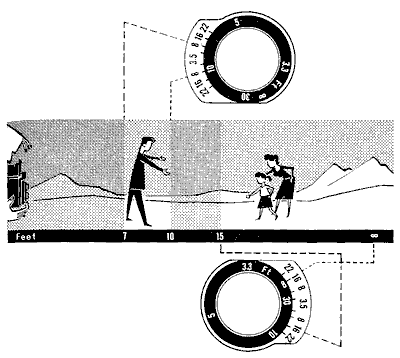
A depth of field scale is engraved around the focusing knob of the Yashica cameras next to the distance scale. It is thus quite a simple matter to read off what area will be in sharp focus for any distance setting and aperture. With the camera focused on 8 ft. (top) the depth of field indicated by the scale for an aperture of f8 is from a little under 7ft. to about 10ft. With the camera focused on 30 ft. (bottom) the depth of field at an aperture of f 16 extends from about 14 ft. to infinity.
|
COMPOSITION
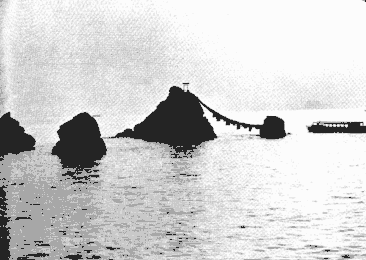
MASS AND TONE. Simplicity is the keynote of many a successful picture. A simple arrangement of shapes on a delicately-toned backcloth can be appealing.
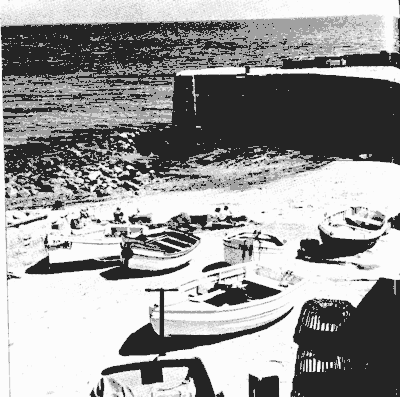
FOREGROUND INTEREST can be overdone. Although boats have popular appeal, it is difficult to arrange them pleasingly and there are often too many of them.
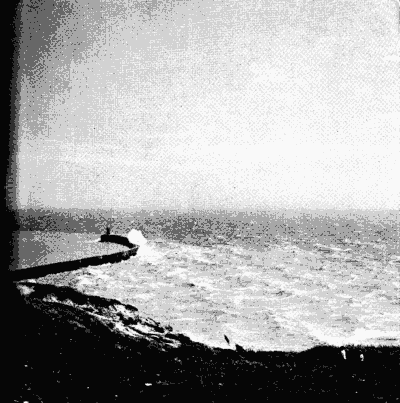
A SIMPLE FOREGROUND adds depth to the picture without drawing attention away from the main subject. The figures set the scale, emphasising the vastness of the scene.
WATCH THE VERTICALS when photographing buildings. You cannot always get them completely parallel, but they should be reasonably so unless you are striving for a special effect Use the viewpoint that shows two sides of the building, helping to create an impression of shape and form.
A DELIBERATE TILT can be effective. Here you throw out the rule book to give your picture impact. The tilt must be violent and it is usually better not to include the base of the building.
|
ACCESSORIES

Above: The ever-ready case of the Yashica 2¼ x 2¼ models. To remove the camera, a raise the two metal slides at the top of the case (left), spread the sides of the case apart (centre) and lift out the camera (right).
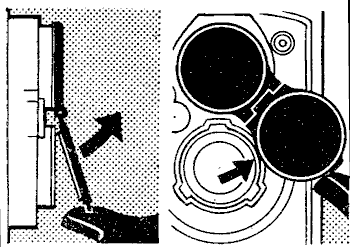
The lens caps of bayonet models. To remove the lens caps, raise the lower cap and fold it back on its hinge (left). Turn the upper cap clockwise (right) and lift the complete assembly away.
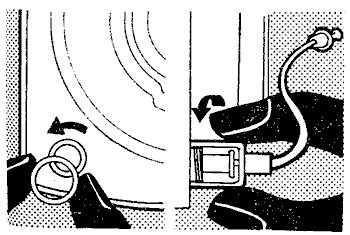
Cable release for all models. To fit the cable release, first unscrew the ring around the shutter release button (left). The cable release then screws over the release button (right).
|
FLASH PHOTOGRAPHY
Flash is an efficient light source where no or insufficient daylight is available, such as at night, indoors, etc. In the flashlight you carry your own private "sun" with which you can illuminate your subject or scene at any time and place.
THE FLASH BULB is similar to a small electric bulb. However, when current passes through it, it lights up in an intense flash lasting usually about¼0 to 1/60 sec. Each bulb will flash only once and has to be discarded afterwards.
The flash bulb is inserted in a flash gun and the current of the battery fires the bulb, while a reflector fixed behind the bulb makes sure that all the light is directed towards the subject. Most flash guns incorporate a capacitor unit which increases the reliability of firing, even when the battery is nearly exhausted. The shutter speed, provided it is slower than 1/50 sec., has no effect on exposure, since the flash is shorter than the exposure time.
Most flash bulbs are available with a clear glass bulb (for black-and-white and negative colour film and for type F reversal colour film) or with a blue-tinted bulb (for daylight type reversal colour films). The blue bulbs can also be used for fill-in lighting by daylight with any type of colour film.
ELECTRONIC FLASH UNITS utilize the discharge of a high-tension capacitor through a flash tube. The power is derived from an accumulator or battery (there are also models working from the mains electricity supply). The electronic flash outfit is rather bigger and heavier than the flash bulb outfit. Its light output is about equal to that of a small flash bulb and its initial cost is higher than that of a battery-capacitor gun. On the other hand, anything from 10,000 to 25,000 flashes are obtained from one tube. The flash duration is extremely short (1/700 to½000 sec.) and will arrest the fastest movements. The cost of an individual exposure is negligible.
Electronic flash is suitable for black-and-white and negative colour film and also for daylight type, reversal colour films. It can also be used for fill-in lighting by daylight.
How to use Flash
The Yashica reflex camera shutters (except A models) are internally synchronized for use with flash bulbs and electronic flash. The cable from the flash gun is plugged into the flash socket of the camera. On releasing the shutter, an electric circuit is automatically closed through the flash socket, setting off the flash at this moment.
The shutter of the Yashica A models have a nonadjustable flash contact which has the characteristics of the X-synchronization described below. On all other shutters the synchronizing lever can be set to X or M.
WITH THE SYNCHRONIZING LEVER SET TO X the shutter closes the flash circuit at the moment when the blades are fully open. Therefore, electronic flash is synchronized at any shutter speed to 1/300 or 1/500 sec. This setting may also be used with flash bulbs with short firing delay (i.e. bulbs which require only 4-6 milliseconds - thousands of a second) to reach the peak of their light output with the shutter set to 1/60 sec. With other bulbs, the fastest usable speed is 1/30 sec.
WITH THE SYNCHRONIZING LEVER SET TO M the shutter closes the flash circuit 16-18 milliseconds before the shutter blades open to allow for the firing delay of most average flash bulbs. This setting is suitable for normal flash bulbs at all speeds up to 1/300 or 1/500 sec. The M-setting will not synchronize electronic flash or short-delay bulbs.
Exposure Guide Numbers
There is a convenient way of working out exposures with flash and this is by means of a guide number. When you buy flash bulbs you will always find the guide number for any speed of film printed on the packet.
To find the correct aperture to use, divide the guide number by the distance between the flash and the subject. For instance, Suppose You find that the guide number of the bulb with he film in use is 160. If you then want to take a photograph tat a distance of 10 ft. from the subject, divide 160 by 10 = 16. Therefore, the correct aperture to use is f 16. Alternatively, if you want to use an aperture of f8 for any reason, then the correct flash distance is 160 / 8 = 20. So the flash must be 20 ft. from the subject.
So far we have assumed that the exposures have been for average shots without much subject movement. For these a shutter speed of 1/30 sec. is long enough to utilize all the light emitted from the bulb. On the other hand, to arrest fast movements a faster shutter speed is required, such as 1/125,1/250 or even 1/500 sec. With each of these speeds a different guide number is needed (usually printed on the flash bulb packet) to determine the correct exposure. They allow for a wider aperture to compensate for the fact that at fast shutter speeds some of the fight emitted from the bulb is lost.
|
FLASH
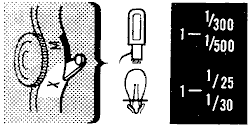 The X flash synchronization Setting is suitable for electronic flash at all speeds and for ordinary (class M) flash bulbs up to1/25 sec. (Model A) and up to 1/30 sec. (All other models).
The X flash synchronization Setting is suitable for electronic flash at all speeds and for ordinary (class M) flash bulbs up to1/25 sec. (Model A) and up to 1/30 sec. (All other models).
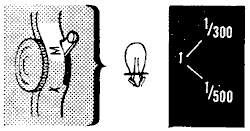 M setting is suitable for ordinary (class M) flash bulbs at all speeds. It is not suitable for flash with electronic flash units.
M setting is suitable for ordinary (class M) flash bulbs at all speeds. It is not suitable for flash with electronic flash units.
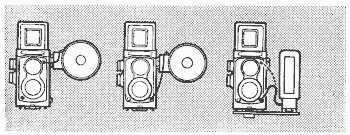
Flashguns can be attached to the Yashica models either by means of the accessory shoe on the side of the camera or by a bracket affixed to the tripod socket in the camera base. Either of these positions may be used, whether the synchronization socket is at the top or bottom of the camera.
|
CAMERA CARE IN TROPICAL CLIMATES
High and widely varying temperatures with low humidity, as occur in desert regions and dry seasons, and very high humidity in rainy seasons, call for special precautions to protect the life and continued good performance of the camera. These conditions also cause the growth of moulds on organic matter, Sand, dust and insects may present problems.
The camera should be kept dry and clean. Leather parts should be wax polished, metal parts lightly greased. Never leave the camera unnecessarily exposed to heat. Always keep it in its case. The lens should be covered with the lens cap when not in use. Outer lens surfaces have to be kept clean, dirt and grit removed with an air-blower and by tapping. Wipe the lens surface with cotton wool or open mesh fabric (butter muslin) when required.
Store photographic equipment in an airtight metal box or a tin which should be sealed with adhesive (e.g. medical) tape. In a humid atmosphere, add some desiccating agent, e.g. silica gel.
Condensation on the lens may occur when the camera is moved from a cool place into humid heat; this has to be removed before use and the whole camera carefully wiped before re-storing.
Films should not be kept longer than six months in their original airtight tins (tropical packing) at continual temperatures of 90°F (32°C). At continual 100°F (38°C), the life of most films is limited to a month or two, Keep films for as short as possible a time in the camera.
Films should be processed as soon as possible after exposure-within a week or two or, in very hot humid climates, within a few days. Keep the film in an airtight container with desiccant (to absorb moisture). If possible, keep in a refrigerator, but only if you can dry out the exposed film and the container is sealed.
|
SUBJECTS FOR THE YASHICA
In dealing with various types of photographic subjects we shall necessarily confine ourselves to those of greatest interest to the average Yashica user. We shall not discuss photography in general but devote our attention to the suitability of the camera for depicting one or the other subject.
Landscapes
To the user of the Yashica who carries his camera as a constant companion, landscapes offer a rich variety of pictorial opportunities. There are, of course, pitfalls, too, The typical picture postcard "view" with wide open foregrounds and the distant background rich in diminutive detail is a somewhat thankless subject. Reduced to so much smaller size than it appears to our eyes, it may drop altogether beyond the resolving power of the film. Much more easy to take are small sections of a landscape with a pronounced foreground. The inclusion of foreground helps to start off the picture with an interesting "profile" providing a hold for the eye and so making the interpretation of distance more easy.
Little subject matter and much characteristic mood yield the best landscapes with the Yashica. Sections of landscapes with a foreground, for example, of water (reflecting houses, hills or clouds), interesting patterns of foreground shadows, particularly in strong sidelight or against the light, lead to successful compositions. On the other hand, landscapes mainly consisting of green values, e.g. meadows with woods in the background usually turn out disappointing.
Winter landscapes are only lively and show up snow and hoar frost if taken in sunshine and with strong side light or against the light.
When taking black-and-white pictures: use a light yellow filter to get true colour rendering. If clouds and distance are to be shown prominently a medium yellow filter is called for, while an orange filter gives dramatic sky and reduces distant haze considerably. When photographing in strong side light and against the light expose for the shadows.
Outdoor Portraits
First and foremost, get away from the fear of approaching close to your subject. The photograph which is half landscape with a figure placed half-heartedly somewhere in it is not a portrait. With the Yashica, 5 to 6 ft. is the most useful portrait distance which will avoid distortion and, still produce a large portrait.
The background deserves special consideration. The less prominent it is the better; it should be kept strictly neutral. a self-coloured wall or a sky being excellent.
The most important point in producing the "lifelike" portrait is the approach to the subject. You will not Let a good portrait by asking for a smile; you will only make the sitter self-conscious and that is the one thing to avoid. Prevent your model from thinking about being photographed by giving him something to do-let him read, smoke, play or work-and then watch for your opportunity to snap.
The perfect light for outdoor portraits is hazy sunlight, strong enough to give good modelling to the face and soft enough to avoid hard shadows. Failing this, shoot in the shadow of a building, for best results. In strong midday sun it is just as well to give your camera a rest. Morning and late afternoon sunlight is helpful, particularly when the sun shines from the side, and slightly in front of your subject.
The possibilities of a reflector in the form of a large sheet of white cardboard to lighten deeper shadows are worth keeping in mind. Use a fast shutter speed and a wide aperture if possible so that you have less depth of field and the background is less prominent.
Available Light Portraits
With fast films it is possible to take Pictures indoors as long as one works in reasonably good light and not far from the window. While practically all that was said about outdoor portraits is also applicable to indoor conditions, one should take into account the fact that if the light is coming from one window only it will cast heavy shadows. These heavy shadows have to be lightened to produce a reasonably balanced negative. This can best be effected by a reflector consisting of a large sheet of white paper, or any other white material, for example, a bed-sheet, a pillow case and so on.
There are two ways in which you can keep the exposure time reasonably short. The sitter may either be placed to one side of the window, with a reflector to lighten the shadows, while the camera is pointed towards him from the other side of the window, or he may sit facing the window, in which case no reflector is needed. The camera may then be placed either in front or to one side of the window.
If two windows are available in one wall, the sitter should be placed between them so that both front and back fighting is given; a reflector should be used to lighten the shadow side and the camera can be used either parallel with the windows or pointing slightly away from them into the room. If the windows are at an angle to each other the sitter should be placed in the corner between them and looking into the room. The reflector is placed facing the corner, while the camera can be put between a window and a reflector. Use a fast film for preference, to keep exposures reasonably short.
Artificial Light Portraits
A good background is supplied by a self-coloured wall, a piece of light or dark cloth stretched taut or simply the frame of an open door leading into an unlighted room. The sitter should be about 3 ft. away from the background.
The exposure time will be fairly short, particularly when two lamps are used, so one can straddle a chair and support the camera on the chair back. If one lamp only is available a reflector must be used to lighten the shadows. The position will be the same as for daylight indoors, the lamp being substituted for the window.
When two lamps are employed, one should be used as a main light source while the other one, farther away, should lighten the shadows. Different lamp positions can give different effects. Do not be afraid, therefore, of moving your lights, or the subject of the camera.
Flash Portraits
Bounced flash is a useful technique. It avoids the unpleasant hard shadows You would have to accept with the flash pointed straight at the subject. All you have to do is direct the flash -upwards to the white or light coloured ceiling; the reflected light is soft and diffused, resulting in an almost shadowless picture.
To determine the correct aperture for bounce flash, use (in place of the direct flash to subject distance) the distance from flash to ceiling plus ceiling to subject. Then set the lens to one stop larger to compensate for the loss of light on reflection from the ceiling.
Children
Assuming that the Yashica user is not fond of posed and sentimentally arranged pictures of children (which after all do not require a technique different from that applied to legitimate portraits), he will have to work inconspicuously. Divert the child's attention by letting him play his games while you play with the camera. Set the lens to a suitable distance and watch until you are sure that the camera does not attract attention. Then shoot quickly. In this way you get not only life-like child studies but also some of the natural surroundings. Avoid looking down at children with the camera-it means dwarfing them in a ludicrously unflattering mariner. Low angles are strongly recommended and are quite easily obtained with the reflex camera.
Sports
As actions worth recording happen, as a rule without warning, you must be ready for them. It is here that knowledge of the game will help. The first problem is to find a Suitable zone of focus which covers the most likely field of action without having to stop down more than is absolutely essential. A small stop necessitates a relatively long exposure time, while on the other hand, short shutter speeds are needed to arrest movement.
Use the frame finder whenever you try to follow the action and keep the other eye open to watch for figures moving in to the picture area.
It goes without saying that fast film is the best safeguard against under-exposure if the weather is not particularly bright; on the other hand, if a fast lens or good lighting conditions are available the medium speed film, on account of its finer grain, will give a better chance of getting sectional enlargements.
In athletics, conditions are as a rule simplified because the position of the athlete is fixed, or at least can easily be predetermined; in athletics too, there is always a dead-point of movement which usually coincides with the moment of greatest interest. Therefore, the distance may be set beforehand and the exposure time will not have to be too fast. Speeds of 1/125 to1/250 second are adequate for reasonably close-up pictures.
Where movements are taken it has to be borne in mind that arms and legs move with at least twice the speed of the athlete's body as a whole. The direction of the movement plays an important part in all sports pictures. For fast movements, or where one's shutter only allows of comparatively slow speeds, it is essential to avoid snapping at right angles to the moving subject but to take the movement towards (or away from) the camera.
|
TAKING COLOUR PICTURES
You will undoubtedly want to take colour pictures with your Yashica. When you have decided which colour film to use, stick to it long enough to become familiar with its peculiarities and with its special requirements with regard to exposure. In this way you will get the best out of whatever material you may use.
Colour pictures should, of course, be coloured, but they need not look like a patch-work quilt. There is no necessity to include all the colours of the rainbow in your picture. You will get a much better effect with a few large patches of wellassorted colours-yellow and blue, for example, or green and red. Close-ups serve almost automatically to limit the picture to one or two large surfaces, each of one colour only.
Subjects for Colour
In choosing suitable subjects for colour photographs, an important psychological fact should be taken into consideration. This is, that most people are apt to notice many more colours in a picture than they do when looking at their surroundings. In everyday life nearly all of us-with the exception of painters-content ourselves with a superficial perception of local colours, whereas when looking at a colour picture we notice secondary shades, coloured reflections, coloured shadows and so on, and in consequence even a picture which faithfully reproduces natural colours is likely to be considered too variegated . Although it is probable that we shall eventually become familiar with the richness of natural colours as rendered in the photographs, it is advisable to avoid subjects which are over-full of strongly coloured shades and reflections.
A deep blue summer sky needs careful handling. The real thing, of course, is enchanting. Even so, without clouds it is apt to look a bit gaudy. If there are dark-coloured objects in the foreground, the danger is already less, because the exposure is taken from these. This means that the sky will
be somewhat over-exposed and will appear a little paler, which is all to the good.
Green is an awkward colour. If it comes out too dark it looks like spinach. Slight over-exposure immediately produces a violent hue. The eye is much more critical of distortion in green than in the other colours, such as red and orange.
In the case of reflections the photographer should remember that a green shadow on a face will give an extremely strange effect when the tree which causes it is not shown in the picture. This is also true for red reflections, such as may be caused by a fire or a red coat,
Snow scenes in colour sometimes show definitely blue shadows. This may at first offend one's vision. But a little experience with snow in the same conditions, that is, beneath a blue sky, will prove that the colour film was right. The shadows, thanks to the reflection of the sky, are blue.
Portraits in Colour
Portraits are a very interesting but rather tricky task for the colour photographer. Deep shadows under chin and nose and in the eye-sockets should be avoided by carefully balanced lighting, which in the case of artificial light should rely for best results on not less than three photolamps and some reflectors. Be sure the reflectors are colourless, also don't place anything coloured over the lamps to achieve soft lighting effects.
Although front lighting, i.e., with light behind the carnera, is the rule, a lens-hood will be found useful for excluding unwanted light from the sides, reflections from white walls, water, and so on. It likewise protects the lens from disturbing light from a Cloudless blue sky above and from the bright reflections from the road surface below. The result is a clearer reproduction of colours.
The rules for taking colour photos of firework displays and thunderstorms are the same as for black-and-white pictures: shutter release at B, shutter open, stop 3.5, focus at infinity.
The shutter is closed when the photographer considers that the film has accumulated a sufficient store of light impressions.
The old trick of using an ordinary electric lamp for lightening the shadows of an object near the window will not work with colour film in the camera if daylight material is used. The side of the object which is lit by the electric bulb appears reddish on the picture. If, on the other hand, you use an artificial light colour film the colours on the daylight side of the picture are not true to life.
Once they have been exposed, colour films should not be left undeveloped too long. Otherwise the colour reproduction may suffer. So once a film has been started, finish it off within a reasonable time, and when the whole film is exposed. do not leave it lying about for longer than you need.
In all cases where colour reversal films are not returned from the processor already cut and mounted, it cannot be too strongly emphasized that they must be divided into individual pictures immediately on receipt, even before examining them. Each individual film should be mounted. Only then are they in a fit state to be handled and admired. This is the only way to prevent damage, finger marks. scratches and so on.
Colour films and prints should not be exposed for long to bright sunshine, or the colours may fade.
|
FACTS AND FIGURES
This section gives the. more important exposure, close-up, zone focusing, using, film, etc., data for tile Yashica reflex in handy tabular form for easy reference.
CONVERSION OF FEET AND INCHES INTO METRIC UNITS
Many cameras are marked only in either the metric or British system, while most of the tables in this book are also given in only one system. The table below shows at a glance equivalent lengths.
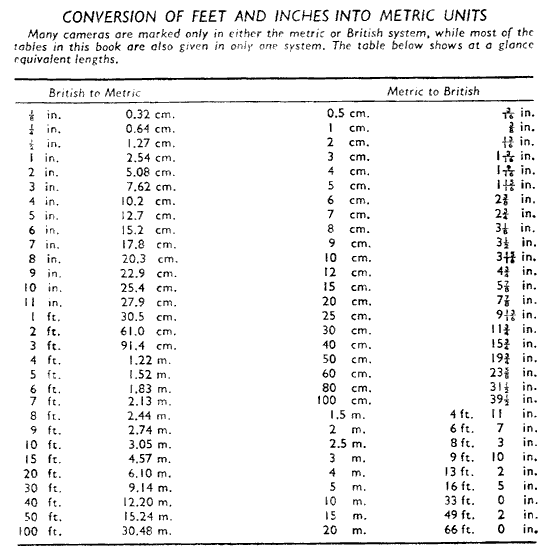

|
DAYLIGHT EXPOSURE VALUES
For Yashica models without exposure meter add up the respective figures in Tables 1 2 and 3. The result is the exposure value to be set. On models without exposure value scale use Table 4 to get aperture-speed combinations (set the shutter to nearest marked speeds if necessary - e.g.1/25 sec. for 1/30 sec.).
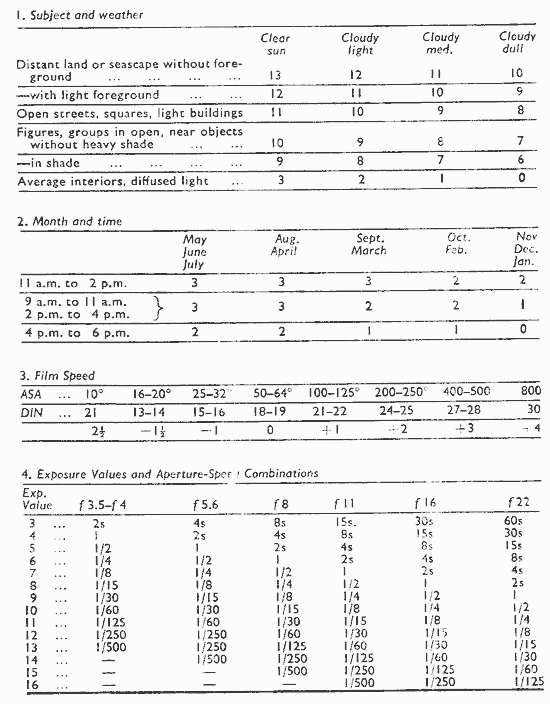
|
SHUTTER SPEEDS TO ARREST MOVEMENT
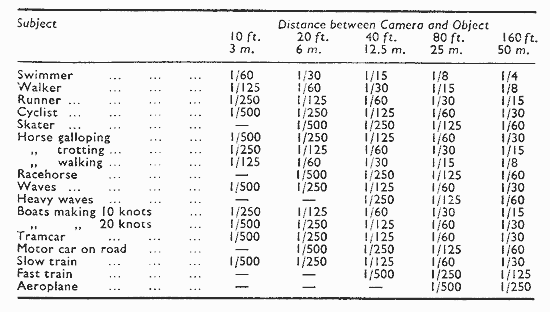 The shutter speeds as listed above are applicable to motion which cuts right across the direction in which the lens and the photographer look.
The shutter speeds as listed above are applicable to motion which cuts right across the direction in which the lens and the photographer look.
If the motion photographed is at an acute angle with the direction in which the lens points the exposure time can be longer, say 1/30 sec. instead of 1/60.
If the subject moves directly towards the lens (or for that matter away from it) the exposure time can be three or four times longer, say 1/8 of a sec. instead of 1/30.
Where the above table shows speeds not marked on the shutter use the next faster speed.
|
APERTURES WITH CLEAR FLASH BULBS (80-100 ASA FILMS)
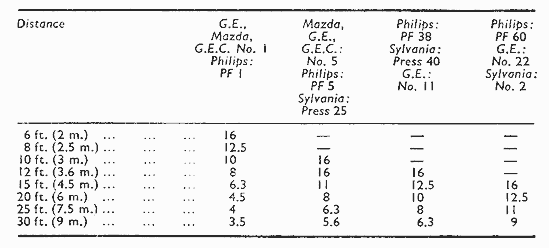
In bright rooms (kitchen, bathroom) or with films faster than 100 ASA, use next smaller aperture. In very large rooms, at night outdoors or with slower 40-64 ASA film use next larger aperture.
|
BLACK-AND-WHITE FILTER DATA
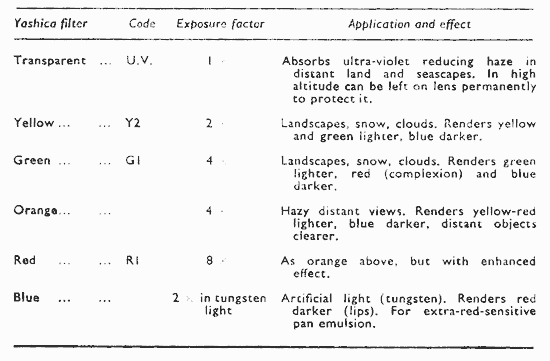
|
COLOUR FILTER DATA
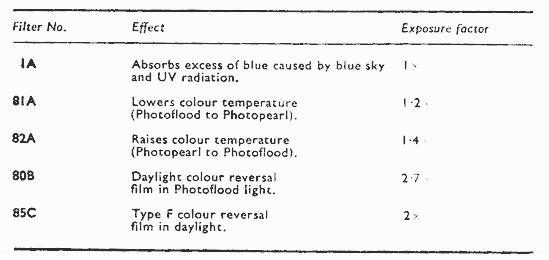
|
CONVERSION OF FILM SPEED SYSTEMS
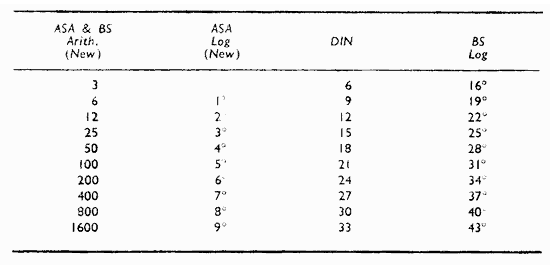
|
CLOSE-UP LENS DATA
The values are approximate
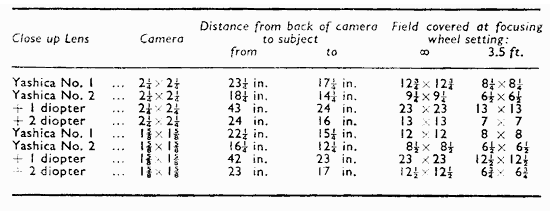
|
APERTURES WITH BLUE FLASH BULBS
(For 32 ASA Daylight Type Colour Film)

|
BLACK-AND-WHITE FILMS
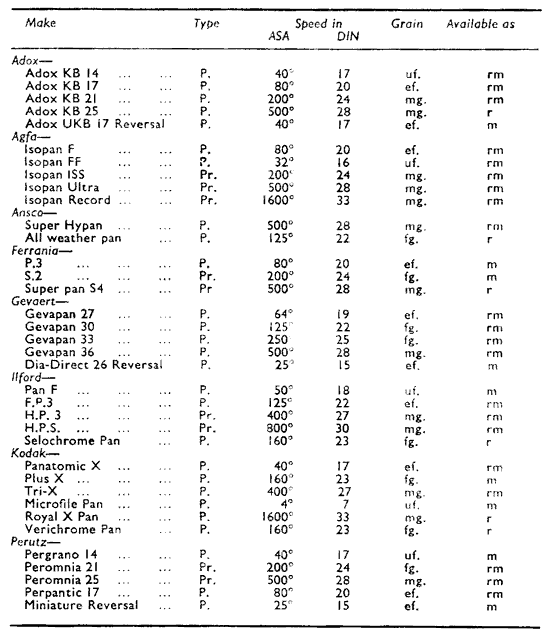
The ASA speeds are the minimum correct exposure ratings (page 19). Some manufacturers may, however, still be quoting their speeds according to the older system to give more liberal exposure. TYPE: P = panchromatic; Pr. = panchromatic with increased red sensitivity. GRAIN: uf. = ultra fine grain; ef. -- extra fine grain; fg. = fine grain; mg - medium grain.
AVAILABLE AS: r = roll film size; m = miniature (35 mm.) film size: the latter can be used only in conjunction with the cine film kit of Model 635.
|
COLOUR FILMS
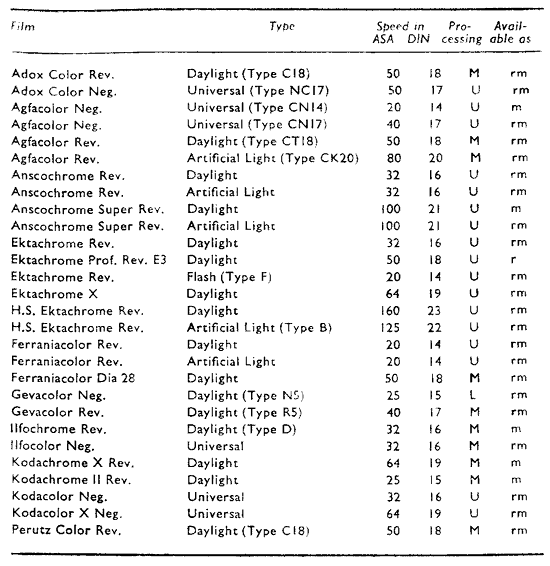
PROCESSING: M = films can be processed only by the maker; L - films can be processed only by an approved laboratory through a photographic dealer; U films can be processed by the user by means of special processing kits.
Available as: r = rollfilm size; m = miniature (33 mm.) mm.) film size: the latter can be used only in conjunction with the cine film kit of Model 635.
|
The Focal
ENCYCLOPEDIA
OF
PHOTOGRAPHY
2,000 articles : 1¼ million words
1,468 pages, 385 photographs, 1,500 diagrams
Bound burgundy buckram, stamped silver
Price GBP 6 6s. (U.S.A. price $22.50)
Desk Edition GBP 1 17s. 6d. (U.S.A. price $7.95)
THE FOCAL ENCYCLOPEDIA will do the job of a whole library. This single volume holds the right answers to any questions on photography-ready for prompt reference. It contains more information than many books put together. Much of it could not easily be found elsewhere. A great deal of it has never been published before.
THE FOCAL ENCYCLOPEDIA covers completely the vast technology of photography and follows up all its uses for picture making. It defines terms, identifies personalities and quotes rules. It recalls past developments and records the present state of progress all over the world. It sums up scientific theory and instructs in up-to-date practice.
THE FOCAL ENCYCLOPEDIA is specially written in plain, readable and commonsense English. It was carefully planned and set out in alphabetical order for easy reference. You will be able to find, instantly master and put to good use, all the information you need from whatever angle you look for it.
THE FOCAL ENCYCLOPEDIA can take the place of a photographic library: and no library is complete without it.
See it at your bookseller's or photographic dealer's or write for prospectus to Focal Press
|
 Download
Download
Download this guide in Acrobat PDF format for easy printing.
|